











Walking the halls of Anuga in Cologne this year, it was clear the global food and beverage sector has entered a new phase, one that feels grounded and purposeful. The focus has shifted from novelty for its own sake to innovation that is meaningful, scalable, and commercially sound. Sustainability and efficiency were not slogans this year; they were central to every conversation, display, and business discussion.
The change in tone was evident among both manufacturers and buyers. Category managers spoke openly about the cooling hype around alternative proteins and meat substitutes. The appetite
for experimentation has not disappeared, but it has matured.
The industry’s approach to innovation now feels more strategic, guided by practicality and genuine consumer demand rather than marketing noise.
Among the thousands of new launches, one concept stood out as a clear example of this shift. Air Up, a German-designed drinking system, flavours plain water through scent rather than additives. The reusable bottle works with aroma pods that release flavour compounds as you sip, tricking the brain into perceiving sweetness or fruitiness while the liquid remains pure water. Each pod can flavour around five litres and contains no sugar, sweeteners, or colouring.
For FMCG manufacturers and retailers, it represents an intriguing convergence of health, sustainability, and design thinking; a refillable system with recurring pod sales that bridges the gap between hydration, wellness, and technology.
This year’s Anuga was not about spectacle or showmanship. The atmosphere was steady, confident, and intent on business. Conversations centred on collaboration, private label innovation, and the role of retail in translating ideas into shelfready products. Optimism was evident throughout the halls and felt justified.
If the past few years have been defined by survival, 2026 looks set to be the year of refinement. The FMCG industry is moving forward with clarity, shaping its own trends rather than reacting to them. That quiet confidence, built on experience and focus, might just be the sector’s strongest signal of progress yet. n

















The Food and Grocery Council is an industry association for grocery suppliers providing members networking, events, industry information and strong advocacy. Contact us for information on the benefits of membership: raewyn.bleakley@fgc.org.nz
• Networking • Industry Updates
• Conference and Events
• Education and Training
• Advocacy and Law Reform

EDITOR-IN-CHIEF Caitlan Mitchell
EDITORIAL ASSOCIATES Sam Francks, Jenelle Sequeira
SENIOR DESIGNER Raymund Sarmiento
GRAPHIC DESIGNER Raymund Santos




The latest Inspire+ event, From Shelf to Shopper, on the 16th of October, at ANZ Sylvia Park.

Wonky Box has entered a bold new chapter with the launch of Good Groceries by Wonky, a reimagined grocery concept for conscious shoppers.






New Zealand businesses will have a better shot at winning government contracts as a result of changes to government procurement rules.

Rolleston has a new local landmark, with the South Island’s largest supermarket officially opening its doors.





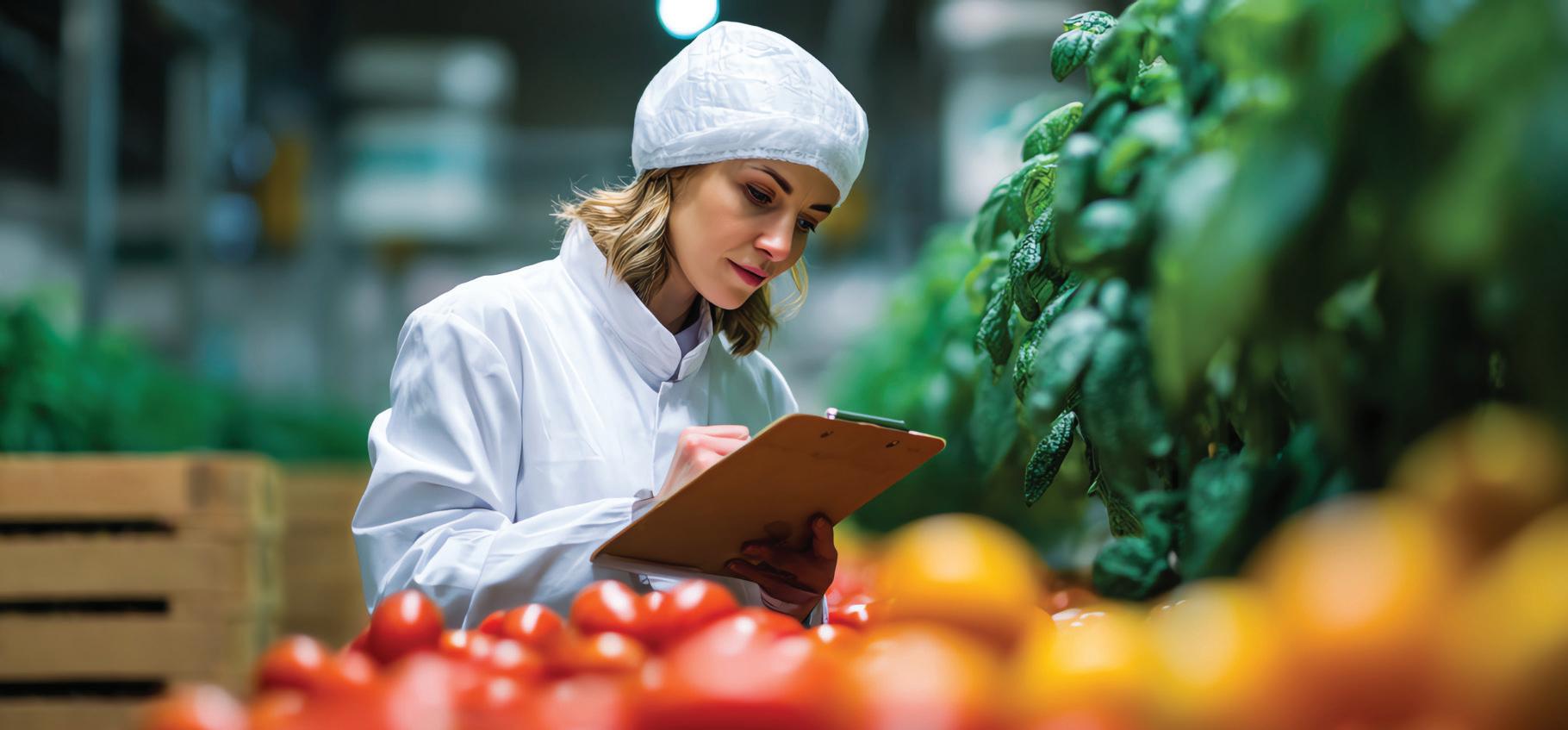
Innovation and technology have driven rapid change in the food sector, and FSANZ's role is to make sure regulation keeps pace.
Dr Matthew O’Mullane, General Manager, Food Safety Branch, Food Standards Australia New Zealand said they have been working to future-proof the system by applying rigorous assessment processes to new foods, updating standards to reflect emerging technologies and exploring how tools like AI could shape the way food standards are developed and applied.
An example he provided was the recent approval of the first cell-cultured food in the region. The assessment of cell-cultured quail was complex, allowing FSANZ to establish a modernised regulatory framework that includes new standards and safeguards public health while providing innovators with a clear, predictable pathway for future approvals of cell-cultured food.
Recent changes to update the definitions of genetically modified foods in the Food Standards Code have been another way to ensure the framework keeps pace with change.
Dr O’Mullane said these examples show how FSANZ can enable industry innovation while keeping food safe and consumers informed.
“Importantly, our approach to these reforms has been among the most transparent globally, setting a benchmark that other regulators are now looking to,” said Dr O’Mullane.
“As food production evolves and new technologies emerge, our surveillance and
monitoring programs help us identify emerging risk and develop appropriate responses, whether they relate to microbial contamination, chemical residues or other food safety issues.”
Dr O’Mullane added that collaboration is central to how FSANZ has developed and maintained food standards. It has worked closely with researchers, industry, public health experts, consumers and its partners across the food regulation system to share information, identify emerging issues and ensure the latest science and technologies are effectively reflected in the Food Standards Code.
Researchers contribute through commissioned studies, expert committees and public consultations, helping ensure our decisions are grounded in robust, up-to-date evidence. FSANZ also engage with industry to understand how new production methods, ingredients and technologies are being used, so our standards remain current and practical.
The national survey of antimicrobial resistance in raw retail meat, the largest since 2008, is providing valuable data to guide future risk management across the food regulation system. At the same time, the 28th Australian Total Diet Study is analysing around 2,000 foods for more than 500 chemicals to monitor dietary exposure.
Together, these studies strengthen the evidence base that underpins food standards and ensure they continue to protect public health.
Internationally, FSANZ has collaborated with organisations such as the Food and Agriculture Organisation, the World Health Organisation and Codex Alimentarius to share food safety intelligence, contribute to scientific discussions and align with global approaches to food risk analysis.
“Innovation only works if people trust it. Our role is to make sure foods and substances produced by new technologies are introduced safely and transparently, with standards that protect public health and keep pace with innovation,” added Dr O’Mullane.
“Safe, innovative food systems don’t just happen. They are built on science, technology, transparency, risk-proportionate regulation, and, most importantly, collaboration among researchers, regulators, industry, dietary health experts, and consumers.”
Public confidence is grounded in transparency, scientific integrity and accountability, the foundations of a food system that is safe, trusted and ready for the future.
By Dr Matthew O’Mullane, General Manager, Food Safety Branch, Food Standards Australia New Zealand.

How fresh a vegetable is can make an enormous difference to its taste, quality and popularity with consumers – and asparagus is a prime example.
Supply of new season asparagus will peak this month, with growers’ hand-cutting more than a million spears daily from crops across Waikato, Hawke’s Bay, lower North Island and Canterbury.
Asparagus is New Zealand’s fastest growing vegetable and under warm conditions, can shoot up an incredible 17cm in a single day. Growers harvest daily to stop the spears from maturing and going to seed before they’re picked.
Good-quality asparagus spears are firm and dark green, with tips that are tightly closed and compact. They should look straight, tender and glossy. Spears with green butts are better than those with white butts, as white butts tend to be tougher. That said, having a little white tissue at the base can actually help slow down decay.
Retailers are encouraged to maintain consistent stock rotation to maximise freshness and boost sales, as asparagus tastes best when it has just been picked. Don’t let it sit on your shelves for longer than a day.
Store asparagus in a chiller, ideally between 0-2˚C. The best display method is to stand bunches upright in water and refrigerate them if possible. When displayed
lying flat, the cut ends dry out and the product deteriorates quickly.
Consumers should be advised to store their asparagus spears in the refrigerator at home and keep the cut ends covered in damp paper towels or standing upright in 1-2cm of water to prevent them from drying out.
Dr Carolyn Lister, Principal Scientist and Science Team Leader (Food & Health Information) at Plant & Food Research, and a Trustee for 5+ A Day Charitable Trust, says asparagus is more than just a seasonal treat.
“Packed with vitamins, minerals, antioxidants and prebiotics, this humble vegetable is a health juggernaut. From supporting gut health to supporting a healthy immune system and helping manage weight and blood pressure, asparagus is one of spring’s best nutrient powerhouses for optimal health.”
Asparagus is full of prebiotic plant fibres that promote the growth of healthy gut bacteria, support regular bowel movements.
Dr Lister adds that asparagus is also a good source of folate, essential for healthy cell growth and function. Eating just half a dozen spears – either raw or lightly steamed –provides around half your daily folate needs.
And if that’s not enough, asparagus contains a wide range of B vitamins (including thiamine, riboflavin, niacin and pantothenic acid) to power your metabolism and nervous system, along with vitamin C for immune support.
New Zealand-grown asparagus will be available through until Christmas, with supplies tapering off again in January.
Help your customers power up their plates and supercharge their health this spring by following @5adaynz on social media for recipes, tips, inspiration and giveaways.







Mintel, the global leader in market intelligence, has announced today three key predictions that highlight opportunities for food and drink brands to strengthen consumers’ resolve to endure adversity now and in the years ahead.
In 2030 and beyond, expect to see a newfound respect for resourcefulness leading to cans, frozen food and other long-life products take the spotlight. Meanwhile, health-focused consumers will use AI as they do with their digital music libraries to ‘shuffle’ their weekly diets to ensure they’re diverse, while inclusive product development will stretch to senatorial innovations for the neurodivergent community. The Mintel 2026 Food and Drink Predictions are:
• Retro Rejuvenation: Brands will be seen as cultural custodians that incorporate, preserve or modernize traditional wisdom with innovations that satisfy consumers’ needs to feel more emotionally and culturally connected to their food and surroundings.
• ‘Maxxing’ Out, Diversity In: Consumers will be hungry to expand their diets beyond just the benefits of protein and fiber. The cultural principle of diversity, equity and inclusion (DEI), will be applied to nutrition, leading to a desire for ‘DEI-ts’ that defy the ‘comfort’ of eating the same foods.
• Intentionally Sensory: Sensory features beyond taste will evolve from being a performative and whimsical element in food and drink to something more practical and pragmatic. Creative, yet evidence-based, use of texture, aroma and appearance will be central to creating innovations that offer inclusive experiences for underserved consumers.
Michelle Teodoro, Mintel’s Associate Director, Food Science, APAC, had this to say about what brands can expect from shifting consumer behaviors:
Retro Rejuvenation
“For consumers in 2026, nostalgia for ‘the past’ does not mean rewinding to a specific year or era. Rather, they are seeking refuge from a volatile and artificially intelligent world in an idealized view that life in the past was simpler. Amid the ‘polycrisis’ of recent years, consumers have gravitated to ancient medicines for stress relief, mindfulness and a pressure-free way to achieve fulfillment. This solace is especially sought by Millennials ages 28-45* who are seeking a higher purpose in the ‘extended middle’ decades life.
“The shocks and disasters that consumers will have survived by 2030 will inspire them to prepare themselves and their pantries to be able to endure whatever surprise is next. Brands that ground themselves in heritage ingredients will benefit from the trust consumers place in history. By 2030, ancestral food practices like seasonal eating, fermentation and natural preservation will evolve from niche interests into mainstream strategies for resilience. Brands will revive techniques like pickling, drying and fermenting—not just as eco-conscious choices, but as culturally rooted solutions that reduce waste, extend shelf life and support gut health.
“Emerging curiosity is also growing around lesser-known yet culturally
significant ingredients, including butterfly pea flower, used for its natural colorchanging properties in drinks across Thailand and Malaysia; moringa, gaining traction in India and the Philippines for its nutrient density; and sea grapes (Caulerpa lentillifera), a coastal delicacy in Southeast Asia now explored for its sustainability and unique texture. These ingredients are being reimagined in contemporary formats—from functional beverages to gourmet snacks, bridging cultural heritage with modern wellness and innovation.
“A newfound respect for resourcefulness will also develop and will inspire a fresh look at cans, pouches, freeze-dried, frozen and other long-life product formats. Retailers will invest in center aisles that improve ‘dwell time’ and inspire discoveries of a new generation of versatile, innovative long-life formats. The comeback of canned tropical fruits and shelf-stable beverages, such as Malee’s fruit juices (Thailand), shows how traditional pantry staples are being reimagined for modern convenience, export growth, and sustainability.
"Maxxing" Out, Diversity In
“At a time when there's an abundance of instantly available health advice, protein and fiber are cutting through the clutter in 2026 and going mainstream as easy to understand, accessible and essential nutrients. By 2030, consumers will shift away from rigid nutritional goals toward a more inclusive, diverse diet. The focus is moving from maximization to balance, and from single-function ingredients to holistic, culturally rooted formulations. In APAC, the emphasis is shifting from maximisation to balance — and from single-function ingredients to holistic, culturally rooted formulations. Consumers are choosing diverse sources of protein and fibre that reflect traditional food cultures and modern nutritional needs: tofu and tempeh are being reimagined in convenient formats; mung beans are rising for their versatility and gut-friendly profile; and seaweed, rich in fibre and micronutrients, is resurging across Japan, Korea and coastal Southeast Asia. Familiar, accessible and sustainable, these ingredients support plant-forward diets that promote overall wellbeing.
“Expect to see parents set their children up with the right nutrients not only for ideal growth and development, but with the foundation of a healthy gut microbiome. We could see precision nutrition boosts such as the customized combinations of seeds, herbs and spices to help consumers amp up variety.
“Just like hitting shuffle on their digital music libraries, health-focused consumers will use AI to ‘shuffle’ their weekly diets to ensure they are diverse, include a range
of ingredients and inspire excitement with new combinations. AI also will encourage trial of new foods with ‘if you like this, then you'll like that’ recommendations of fruits, vegetables, grains, seeds, spices or proteins that are new, but familiar. Brands that innovate with nuance, cultural relevance and foresight will be better placed to meet the needs of consumers.”
“Whether it's ‘dirty sodas’ or Dubai chocolate, multi-sensory innovations have become synonymous in recent years with playfulness, novelty and viral sensations. In the future, brands will be more intentional with their use of color, texture or aroma to create food and drink that stimulates the senses and reinvigorates experiential eating and brand positioning.
“Innovations that engage several senses will serve as antidotes to increasingly virtual, repetitive and isolated daily lives. In China, Mintel research shows that 34% of consumers look for chewy snacks and 30% for crispy ones, showing a strong preference for diverse and exciting textures. By 2030, multi-sensory inspiration also will come from empathetic explorations of how to formulate for the unique sensory needs of underserved consumer groups, including the elderly, neurodiverse individuals or GLP-1 medication users, while enticing mainstream consumers.
“Brands have an opportunity not just to reimagine traditional food and drink,
but also to reimagine the consumption occasions where they can be applied, providing a whole new way to remain relevant to Generations Z and Alpha. Opportunities will emerge for food and drink brands to use multi-sensory elements such as aroma, audio or video to modernize consumption occasions that were iconic for previous generations. For example, across APAC, social rituals are taking on a softer, more mindful form. The rise of ‘soft clubbing’ experiences like Australia’s Maple Social Club is turning early mornings into social wellness gatherings, where community and coffee replace late nights and loud music. In Southeast Asia, night markets are evolving into sensory food festivals that celebrate local flavour and creativity, while modern tea houses and breakfast cafés blend aroma, design, and taste to create calmer spaces for connection. This evolution signals how the next wave of social experiences will blur the lines between wellness, indulgence, and community, reshaping how consumers come together. Understanding the sensory expectations of consumers, from texture to aroma to emotional payoff, will be key to creating products that resonate.”






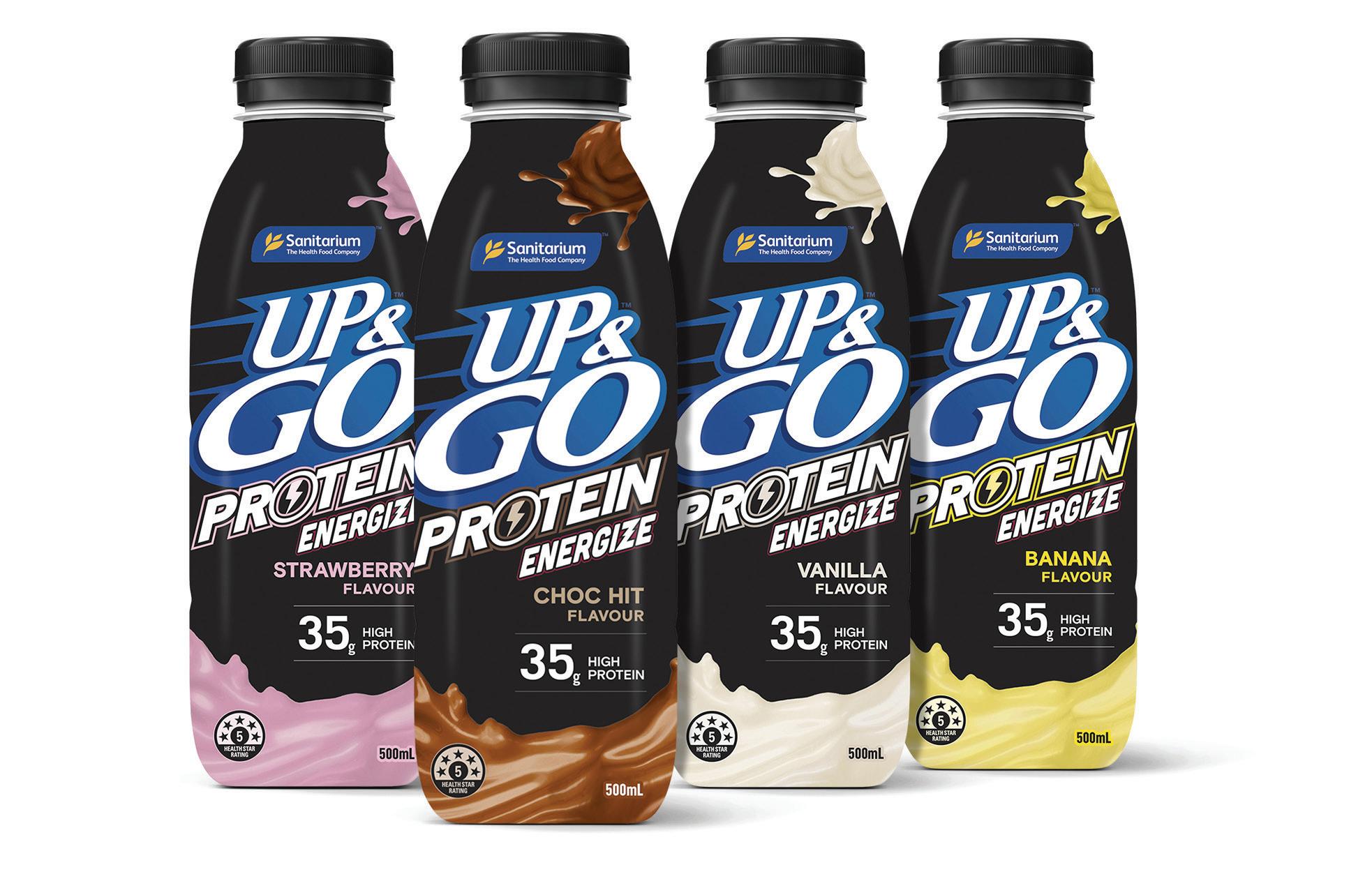
In today’s fast-paced world, Kiwis seek breakfast options that are quick, nutritious, tasty, and satisfying.
As New Zealand’s number-one breakfast brand in Grocery (Circana Scanned Sales 26wks or 13wks to 21.29.25), UP&GO has continued to dominate the convenience breakfast category in NZ Grocery, through innovation, nutrition, and mass appeal.
UP&GO’s success has been sustained by its simple promise of a winning combination of energy and nutrition in a convenient format. Each serve boasts protein, fibre, and 11 vitamins and minerals, including calcium; to support essential nutrient and energy needs. With a wide range that caters to everevolving dietary preferences, the brand’s portfolio includes High Protein, No Added Sugar and Dairy-Free options. This variety has ensured that there’s an UP&GO for everyone.
From family fridges to gym bags and convenience shelves, UP&GO is available in multiple pack sizes and formats designed for
both at-home and on-the-go consumption.
Consumers can choose from 12-packs, 6-packs, and 3-packs for household stocking, as well as 350 ml and 250 ml formats, alongside the popular 500 ml chilled bottles for immediate enjoyment.
The flavour range is equally broad, covering familiar favourites and indulgent innovations, including UP&GO: Choc Ice, Vanilla Ice, Strawberry, Banana, Iced Coffee and new Iced Mocha; Protein Energize: Choc Hit, Vanilla, Strawberry, Banana; No Added Sugar: Choc Ice, Vanilla Ice; and Dairy Free: Choc Ice, Vanilla Ice flavours.
Protein has become one of the fastestgrowing health trends not just in New Zealand but across the globe, and the latest launch, Protein Energize Caramel flavour, has tapped into this trend perfectly.
Behind UP&GO’s success is Sanitarium, a trusted name in the industry, as voted by consumers in the Reader’s Digest Trusted
Brand Awards*. To accelerate growth, UP&GO has been supported by the brand’s biggest-ever media investment, with a ratecard spend exceeding NZD 9 million.
The brand’s latest UP&GO Protein advertising campaign, launched in August, also reflects Sanitarium’s long-term confidence in the brand and in the broader breakfast-on-the-go category.
Whether it’s a quick on-the-go breakfast option before school, fuel for a gym session, or a pick-me-up between meetings, UP&GO is a perfect choice for New Zealanders looking to get up and go for convenient energy on the move.
*https://www.sanitarium.com/nz/ouringredients/your-vote-for-trusted-breakfastbrand
SOURCE: Circana Scanned Sales Liquid Breakfast and Breakfast Cereals 26wks or 13wks to 21.29.25


With grocery announcements and changes coming thick and fast, it’s no easy task to keep up to date. After all, plenty has happened in a short space of time - it was only in mid-2023, a little over two years ago, that New Zealand’s first Grocery Commissioner was appointed.
Cost of living challenges and a commitment to improving competition are continuing to drive successive governments to take action in a variety of areas. For grocery this has meant a constant spotlight on the mechanics and machinations of many facets of our complex industry. We has faced a prolonged, heavy regulatory workload with multiple activity streams that often overlap and it’s not over yet - the intensity will continue for some time to come.
While it’s a lot to get your head around – the NZFGC is here to support suppliers and the businesses around them through. It’s imperative that suppliers have a comprehensive working understanding of the Grocery Supply Code and be able to negotiate confidently and compliantly, because even though the Code has been under review since June 2024, compliance is still required.
The NZFGC has been working to make
suppliers’ views understood by decision makers and enlisting the assistance of experts on the Code throughout. Since the first Code’s introduction in September 2023 in conjunction with our training partners, NextGen Group, we have and have trained over 700 industry executives.
And with a revised Code soon to be in place we’ve recently launched two new training opportunities to help suppliers operate in the new environment, with options to suit different levels.. Delivered through either open or in-house workshops, we offer practical, case-based training, equipping teams to understand and work with Grocery Industry Competition Act and Code obligations confidently now and in the future. The programme includes real-world scenarios and supplier-retailer case studies, as well as advice on raising concerns and working constructively with the Code.
The full day ‘101’ option is designed for those new to the industry and the Code, covering the basics in fair and transparent supplier-retailer relationships, and is suitable for all customer-facing roles, including sales, marketing, category, and supply chain.
The second ‘102’ course is a half-day refresher option looking at the first 18 months under the Code, what’s changed in practice and how suppliers can apply it in everyday interactions with retailers.
We’re proud to partner with NextGen Group, a hugely respected Australasian FMCG consultancy, to deliver this training opportunity for members. NextGen Group know the regulatory landscape’s background and current changes, and expertly break the
complexity down into engaging and practical information to help you understand and work with the Code in your business. And because change is constant in this area, the material is updated regularly to reflect the very latest developments.
Companies attending NZFGC Conference in Ōtautahi Christchurch will be able to hear directly from Minister Willis , the Grocery Commissioner Pierre van Heerden an expert panel with NextGen’s Mike Rudman and Anthony Grant, joined by Minter Ellison Rudd Watts’ Jen Hambleton. The leaders of the major grocery retailers will also each present making this year’s conference unique with all these pivotal speakers within two days rounded out with valuable industry updates, inspirational business speakers and of social networking opportunities for good measure! Back to all this regulatory change in the industry - we understand deeply the rapid change of the last few years hasn’t been easy , so we’ve supplemented the Grocery Code training programme with memberonly free webinars to keep you across latest developments, and what they mean for you. The bottom line is that we’re here to help you make sense of the regulation and make the best decisions for your business. If our conference or ongoing support sounds beneficial to your team or you have questions, get in touch at admin@fgc.org.nz.

Raewyn Bleakley Chief Executive, New Zealand Food & Grocery Council
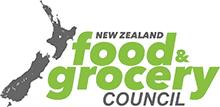
Rob is a commercially driven FMCG leader with a dynamic career spanning multinational giants and nimble SME environments. With a proven track record in strategic retail operations, national account management, and commercial planning, Rob has consistently delivered results across both New Zealand and Australia’s most competitive supermarket chains.
His experience includes leadership roles at Simplot, Wattie’s, Mars, and KML, where he honed his ability to build and scale FMCG businesses across diverse models. Rob thrives in complex corporate structures while maintaining an entrepreneurial mindset — a rare combination that makes him a trusted partner in driving innovation and sustainable growth.
Rob brings a unique blend of strategic vision, commercial acumen, and people leadership. He is passionate about mentoring emerging talent and driving growth across the retail landscape for our valued brands.
• rmarshall@alliancemarketing.co.nz | +64 21 197 9793





As Alliance Trading continues to expand its footprint in the New Zealand grocery and distribution landscape, we are proud to announce the promotion of Jamielle Lewis to General Manager –Alliance Trading.
Jamielle brings a wealth of experience and a proven track record in our Alliance Marketing business in building and executing successful brand launch strategies. Her deep understanding of the grocery sector, strong commercial acumen, and inquisitive mindset makes her uniquely positioned to lead Alliance Trading into its next phase of growth.
With a keen eye for identifying white space opportunities and a passion for excellence, Jamielle has consistently demonstrated her ability to drive results and foster innovation. We are excited to see her leadership continue to shape the future of our business.
• jlewis@alliancetrading.co.nz | +64 21 986 513




Multi-year purchasing—plus convenient collection and better design—turns good pilots into national systems.
As I step into the role of CEO at The Packaging Forum, our focus stays the same: scale circular systems that work, fund them fairly, and keep outcomes transparent. In my first weeks I've been meeting with retailers, brands, councils and recyclers to understand the challenges they face. Three things stand out: people want practical collection and recycling solutions now; convenient access turns intent into action; and local reprocessing grows when buyers commit to purchase recycled end products every year so processors can invest with confidence.
Packaging's first job is to protect products through the supply chain, keep food safe and fresh, and prevent waste. What happens next is where New Zealand still has work to do. Collection is only half the job. If no one buys what our recyclers make, there's no demand for good-quality material and circular systems stall. A clear way for organisations and for all of us to close the loop is simple: buy recycled where we can.
That means retailers and brands commit up front to buying recycled products each year so processors can plan, hire, and invest

for the long term—turning good pilots into national systems.
Having worked on packaging systems globally, I've seen what separates programs that work from those that don't: committed buyers. In parts of Southeast Asia without formal collection systems, only high-value items like metal cans and PET bottles get recovered because they have resale value. New Zealand starts from a stronger base with kerbside and drop-off infrastructure. Now we need the purchasing commitments to match.
For retailers and brands, three practical actions now: Specify recycled products in store builds and refits, distribution centres and back-of-house—think posts, rails and bollards; interior panels and fixtures such as those from Future Post and saveBOARD. Make it a multi-year promise by putting minimum yearly volumes into procurement and supplier contracts so recyclers have certainty to grow. And publish what you buy—share the numbers so people can see returns turning into useful products in their own communities.
Spreading purchases across retail, logistics and council projects smooths demand and
creates room to add collection points and divert more packaging from landfill.
Households and public spaces are where people decide whether an empty pack is a resource or rubbish. Convenient access is what turns intent into action: kerbside is the most convenient option with the correct investment by those who benefit from it. Targeted collection points for materials that aren't kerbside yet also support. What works consistently across take back collection sites—whether at supermarkets, retailers, or community hubs—is visible bins, plain-English signs, and regular servicing. Make it easy and people participate. Using standardised signage and keeping bins clean lifts participation and keeps logistics efficient. We’re also pushing hard for a single, national recycling label, so New Zealanders know exactly what to do with every pack.
For producers and brands, the design lever matters. Design to be recycle-ready: fewer materials, easy-to-sort formats, avoid disruptive inks, labels and closures, follow standardised recycling guidance, and optimise pack size and weight. Use recycled content where it's safe, fit-for-purpose
and commercially viable. Share simple SKU data—weights and materials—so measurement and traceability improve. Trial reuse and refill where it makes commercial sense, as it prevents waste and complements recycling. And explain choices to customers so better habits stick.
We're working constructively with government on settings that could enable producer stewardship across all packaging—with reuse and refill recognised within the same framework—so pilots become durable national systems. The aim is system stewardship: reward better design, cleaner flows and strong local end markets, rather than shifting problems between materials. Extended Producer Responsibility, or EPR, means producers help pay for and improve recycling based on how their packaging performs.
The Packaging Forum with the NZ Food & Grocery Council has also submitted recommendations on the design of a mandatory Plastic Packaging Product Stewardship Scheme to the Ministry for the Environment. This report outlines
a producer-led system to manage and reduce the environmental impact of plastic packaging. More than just plastic packaging, we would like to see an EPR system for all packaging materials introduced here that would adequately fund the net costs of collection, sorting, and reprocessing of materials
We're advocating for options that ensure if EPR is implemented in New Zealand, it's shaped in the most effective way. The Packaging Forum's voluntary product stewardship schemes are proven building blocks for this transition.
New Zealand has made progress: kerbside is becoming more consistent, onshore processing capacity is growing, and voluntary stewardship continues to show what's possible, but we need a system change through EPR to bring ourselves up to global best practice and for our exporters to meet the targets set out in the EU’s Packaging and Packaging Waste Regulation (PPWR).
The next step is locking in reliable offtake (purchasing of recycled output products) so processors can plan, hire and invest for
the long term. If you're a retailer or brand, here's my ask on behalf of The Packaging Forum and our members: Commit to buying recycled where you can. Join the schemes. Share your data. Help us test practical solutions—so what New Zealanders return through kerbside and collection points becomes the posts, panels and fixtures that keep our circular systems moving. n
don't buy recycled!
Creating a circular economy turning our soft plastic waste into consumable products
Increasing recycling rates of food and beverage cartons and recycling them into sustainable building supplies
Diverting caps andlids from landfill, and instead placing them back intothe circulareconomy
FUNDING RESOURCE RECOVERY & RECYCLING scan the QR code to find out what products are made by our partners
Increasing recovery of container glass and improving recyclability







Onfire Design has taken home two Gold Pentawards this year for its work on Salash and Holy Aioli, a testament to its continued creative rigour.
Since its founding in 2007, the Pentawards has grown into the world’s leading competition devoted exclusively to packaging design, with more than 2,000 entries from over 60 countries judged each year on execution, brand expression, innovation and emotional impact.
The 2025 gala was held on the 4th of October, at De Kromhouthal in Amsterdam, coinciding with the city’s 750th anniversary, making this year’s celebration a landmark occasion.
Natasha Alimova, Onfire’s Design Director, made the trip over to be in attendance.
Against that backdrop, Salash, an SME navigating a category dominated by multinationals, won Gold for Packaging. The recognition followed earlier honours from Communication Arts, World Brand
Design Society, AGDA, NZ Best Awards and Type Directors Club New York. It underlined how rigorous, design-led thinking can enable a small brand to punch far above its weight on a global stage.
"The awards that followed are a strong vote of confidence for our client, our team, and for the belief that bold design can reposition a smaller player with ambition," said Onfire founder Sam Allan.
Not to be outdone, Holy Aioli claimed Gold in the Re-design: Challenger Brand category. Proof that putting unapologetic food porn on a label can pay dividends, and that challenger attitude can be as effective on the shelf as it is on the creative stage.
As Onfire marked its 20th anniversary, the message is clear: New Zealand design is not simply present at the table, but helping to define it. n







Alliance Marketing
Giving your dog their medicine doesn’t have to be a battle. With Evolution Naturals Pill Pillows, you can turn a stressful chore into a simple, tail-wagging moment. These soft, mouldable treats are specially designed to wrap around tablets or capsules, masking both the taste and smell of medication. Just pop the pill inside, pinch the ends closed, and your dog will think they’re getting a treat not their daily dose.
Crafted from all-natural ingredients, Pill Pillows are gentle on your pet’s stomach and perfect for even the fussiest eaters. Their delicious chicken and liver flavour makes them irresistible, so you can say goodbye to hidden pills in cheese or peanut butter.
Proudly 100% Australian-made, Evolution Naturals Pill Pillows make medicating your dog simple, convenient, and stress-free for both pets and their people because happy dogs make for happy owners.
Farrah's
Farrah’s is excited to launch its NEW Low Carb High Protein Wraps, the first high protein wraps to hit supermarket shelves in New Zealand. Delivering category-disrupting innovation, these wraps join Farrah’s successful Low Carb range to meet the rapidly rising demand for protein-packed products and make hitting your protein and nutrition goals both delicious and convenient. Packing a powerful punch with 11.2g of protein per wrap, they are perfect for active consumers seeking balanced meal options to fuel performance – from gym-goers and outdoor enthusiasts to meal preppers and macro trackers. With only 4.2g of carbs per wrap, they’re also ideal for those living a keto-friendly or low-carb lifestyle.

“We’ve pushed the boundaries of innovation to craft the perfect protein-packed base that doesn’t compromise on quality or taste,” said Jasmine Currie, Farrah's Head of Marketing.
True to Farrah’s commitment to quality, these wraps are veganfriendly, yeast and dairy-free, and proudly flame-baked right here in New Zealand.
For more information on Farrah’s Low Carb High Protein Wraps and delicious recipe inspiration, visit www.farrahs.co.nz.
Alliance Marketing
Treat your dog to something truly special with Reward Pet Treat Co. Beef T-Bone Bites. Made in Australia from premium ingredients, these soft and chewy morsels are packed with highquality protein, essential vitamins, and nutrients to keep your dog healthy and happy. Perfect for training or everyday rewards, they’re a treat your dog will love every time.


Alliance Marketing
Keep your cat’s teeth healthy and their purrs coming with Reward Pet Treat Co. Cat Dental Treats. Made in Australia from premium ingredients, these crunchy bites are packed with high-quality proteins, essential vitamins, and nutrients to support daily dental health. Perfect as a tasty everyday reward, they help reduce plaque and keep your cat’s mouth fresh and clean.
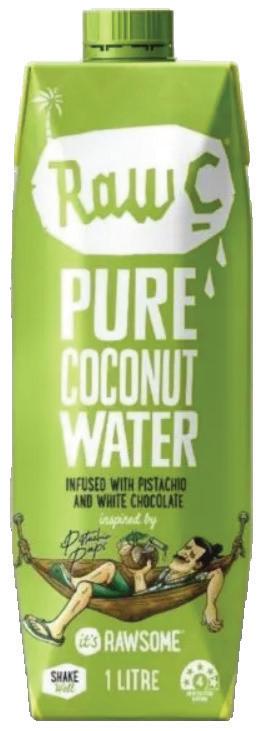
Natural Raw C x Pistachio Papi
Natural Raw C has announced its firstever collaboration with Pistachio Papi. This is the world's first coconut water infused with pistachio and white chocolate.
Natural Raw C Coconut Water Infused with Pistachio and White Chocolate is the ultimate guilt-free indulgent sip: creamy, dreamy, and impossible to put down. It is also vegan, dairy-free, and all-natural and is now available at Woolworths.

Bulla Murray Street Ice Creamery
Pistachio flavoured premium ice cream with raspberry sauce and caramelised pistachio pieces.
Since 1929, Bulla has been making some of Australia’s creamiest, tastiest, award-winning ice cream at their factory on Murray Street in Colac, Victoria. Located in the heart of one of Australia’s best dairy-farming regions, the brand has made ice cream the way it should be, with fresh Australian milk, cream and six generations of craft and know-how.

Funday Natural Sweets
Introducing Fruity Strawberry + Mango Passion Chews – juicy, stretchy, and bursting with bold flavour. These chews bring a refreshing party to your mouth, combining sweet strawberry with tangy mango passion. Fun, fruity, and better-foryou, they’re the kind of lolly that keeps the vibes going all day long.

MILKSHAKE SUPA POP
Twisted Healthy Treats
Full of supa flavour, meet Strawberry Milkshake- the Supa Pop made for Supa kiddos, with 100 per cent Aussie dairy, all-natural ingredients, and zero added sugar. It’s delicious, drool-worthy and ready to make your mouth very happy. This is one treat you’ll wanna unwrap on repeat. Find them in Woolworths freezers.





In the heart of the South Island, Four Square Omarama has become a great example of community spirit, innovation, and adaptability.
Since taking ownership, Dave and Kim MacKenzie have transformed the store into a modern, customer-focused hub while maintaining the friendly, small-town charm for which Four Square is known.
“Our goal from day one has been to build a store that truly reflects our community, modern, efficient, and welcoming,” said Dave MacKenzie, Owner-Operator of Four Square Omarama.
“We wanted to create a space that not only serves the locals but also enhances the experience for travellers and cyclists passing through.”
As consumer habits have evolved, Four Square Omarama has identified
and invested in high-growth categories. One area that has shown exceptional performance has been impulse, muesli bar, and nutritional snacks, reflecting the growing demand for health-conscious, onthe-go eating.
“This category has shown remarkable growth potential. In fact, we’ve seen over 100 percent growth in the past year alone. By creating a dedicated fixture and expanding our product range, we’ve been able to meet customer needs while driving innovation in-store.”
The team has focused on expanding its product offering and enhancing the overall store experience to align with Omarama’s active, health-conscious community. The store’s location along the A20 cycle


network presented a unique opportunity to cater to cyclists seeking high-energy, nutritious, and convenient options.
“We see huge potential in offering products that support endurance, recovery, and wellness. Our goal is to become the goto destination for cyclists, a place where they can refuel and refresh before continuing their journey.”
“We’re lucky to be so close to one of the best wine regions in the world. Central Otago Pinot Noir has such a distinct character; it’s something we love showcasing on our shelves.”
We see huge potential in offering products that support endurance, recovery, and wellness. Our goal is to become the go-to destination for cyclists, a place where they can refuel and refresh before continuing their journey.
Plans are also underway to introduce a walk-in beer and wine chiller, providing a cool, inviting space for customers to unwind, whether they’re locals, holidaymakers, or cyclists stopping in after a long ride.
Additional refrigeration across the carbonated soft drink and energy drink categories will further support the store’s summer focus, ensuring a diverse and refreshing beverage selection.
Another department that has been central to the store’s recent success is fresh produce, particularly during the summer months. From peaches and nectarines to plums and cherries, summer stone fruit has delivered strong sales and become a defining feature of the store’s seasonal range.
Four Square Omarama also champions locally sourced products wherever possible. Central Otago’s world-renowned Pinot Noir is a particular point of pride.
When the MacKenzies took over Four Square Omarama, their goal was to transition the store to the new format: modern, fresh, and aligned with Foodstuffs’ latest brand vision.
The initial phase included installing Electronic Shelf Labels (ESLs) to streamline promotions, improve pricing integrity, and enhance customer trust. Operational improvements, including refinements to inwards goods and restocking processes, also boosted efficiency.
To enhance the customer experience, a new sound system was also installed, transforming the store’s atmosphere with upbeat Spotify playlists. The interior refurbishments, including ceiling and timberwork, were carried out after hours to avoid disrupting customers.
The MacKenzies have now embarked on their next adventure with the acquisition of Four Square Fairlie.
“Fairlie was always at the top of our list. The timing might be ambitious, but we’re excited to bring the same energy and vision to our next project.” n





A 2023 UC Davis study has found that most private-label avocado oils are either rancid or adulterated.
Avocado oil has become a popular choice for many people in recent years because of its hearthealthy benefits and versatility in cooking. However, not all avocado oil products on store shelves are created equal.
Some products have been labelled as “pure” avocado oil when they contain other oils or additives. No enforceable standards defining the chemical and physical characteristics of avocado oil exist yet.
Researchers at the University of California, Davis, analysed samples of 36 private-label avocado oil products and graded them based on quality and purity. Private label products are made by a thirdparty processor and sold under a grocery store or retailer's brand label.
Their findings, published in the journal Food Control, show that 31 percent of the samples tested were pure, and 36 percent were of advertised quality. Quality refers to whether the oil is fresh or has gone bad due to ageing, heat or light exposure. For purity, researchers measured fatty
acids, sterols and other components that differentiate avocado oil from other oils.
The study included oils purchased from 19 retailers in the U.S. and Canada with various price points. They found that lowerpriced oils were more likely to be tainted with other oils.
“We found that low-cost products indicate a higher probability for adulteration, but high cost didn’t guarantee purity or quality,” said Selina Wang, associate professor of Cooperative Extension in the Department of Food Science and Technology. She and Hilary Green, a postdoctoral researcher at UC Davis, co-authored the paper.
Researchers also identified certain chemical markers in avocado oil that professional retail buyers can use to make more informed decisions when it comes to choosing suppliers. This way, consumers can feel confident about the products they buy.
This is the second comprehensive study conducted by UC Davis researchers on the quality of avocado oil sold in the U.S. The first study released in 2020 found that many of the test samples were of poor quality, mislabeled or adulterated with other oils.
“This study demonstrates that although progress is being made in standard development since our first market study in 2020, there are still issues with purity in avocado oil, and these issues extend
significantly into private label oils.”
Since the release of the first UC Davis study, Wang said there’s been a coordinated effort by researchers, industry leaders and government agencies to establish enforceable standards. The Avocado Oil Expert Group was formed in collaboration with the American Oil Chemists’ Society to discuss potential standards and future research projects.
Wang’s research group has been studying how natural factors like different types of avocados, harvest times, geographic origins and processing methods could affect the chemical composition of avocado oil. They aim to establish standards that accommodate natural variations while detecting any adulterations.
Wang hoped that the study’s findings would contribute to the establishment of standards that benefit both consumers and avocado oil producers who want to compete in a fair market.
“I’m very optimistic for the future of the avocado oil industry. It’s a high-value product with high consumer demand, similar to what I saw with olive oil 10 years ago. Olive oil quality and purity have improved significantly, which is where I see avocado oil going, if we can establish fair standards and eliminate fraudulent products.” n


Handee paper towels are an essential kitchen tool. From wiping up kitchen messes to patting meat dry, Handee helps streamline cooking tasks while maintaining hygiene. Its strength and absorbency make it a reliable companion for everyday meal preparation. But how can Handee help prevent your pipes clogging up?
When fats, oils, and grease (FOG) enter the wastewater system, they don’t simply wash away. Instead, they cool, harden, and cling to the insides of pipes. Over time, these deposits grow, trapping other debris and forming fatbergs, some of which have been known to weigh several tonnes and cost millions to remove from wastewater systems.
Water authorities across New Zealand have long urged households to dispose of cooking fats in the bin, not the sink* Handee is a pro at picking up grease, absorbing oils so they can be safely thrown away, rather than washed down the sink. Using Handee to wipe out pans and roasting trays before rinsing, households can reduce the amount of oil entering the drain, helping protect plumbing and prevent environmental damage. That’s powerful performance with a practical purpose.
One Handee sheet has been proven to absorb up to 4 teaspoons of olive oil**. Due to Handee’s superior absorbency, fewer paper towels are required to clean up, which not only reduces waste but also saves money over time. Now that’s Handee!

Taste the Mediterranean with The Olive Lady’s Extra Virgin Olive Oil, cold-pressed in Greece from the revered Koroneiki olives and famous for their high concentration of healthprotecting polyphenols.
This exceptional oil boasts superior antioxidant power, supporting heart health and reducing inflammation. Drizzle this Greek liquid gold for its rich flavour and natural benefits. Perfect for customers wanting to elevate their well-being!
Bringing authentic Greek products to New Zealand since 1996, The Olive Lady knows her olives…and olive oil. Simply Greek Cuisine!
Become a stockist by emailing sales@theolivelady.co.nz or calling 021 537 268. Visit www.theolivelady.co.nz to see our exciting range.
From orchard to bottle, Trickett’s Grove Extra Virgin Walnut Oil has been produced by a co-operative of around 45 walnut growers across the South Island. The brand dates back to the 1970s when the first trees were planted in Canterbury. Today, the nuts are still grown with minimal intervention, pruned, fed, watered, and left to thrive naturally. Several orchards have been certified organic, reflecting the growers’ shared commitment to sustainability and quality.
All walnuts have been processed locally at the group’s Tricketts Road facilities in West Melton, ensuring complete control over freshness and flavour. The oil is cold-pressed from 100 percent New Zealand walnuts, a process that protects delicate nutrients including omega-3 fatty acids, antioxidants, and vitamins.
The result is a rich, nutty oil that can enhance everything from salad dressings to roasted vegetables and baked goods. Beyond the kitchen, its health profile supports heart, skin, and brain health, making it an award-winning product.
Trickett’s Grove Extra Virgin Walnut Oil is available in 100 ml and 250 ml bottles, offering a taste of Canterbury’s walnut heritage in every drop.
For more information, visit trickettsgrove.nz or contact sales@walnutsnz.nz


Cobram Estate Classic Extra Virgin Olive Oil supports heart health when consuming 30mL or more each day as part of a balanced diet. Its fresh and vibrant flavour profile makes it a perfect all-rounder in the kitchen and ideal for roasting, baking, frying or drizzling.
Cobram Estate Classic Extra Virgin Olive Oil is available in all major NZ retailers, including selected Woolworths, New World and Four Square stores.
For more information, visit cobramestate.com.au
The Good Oil is supporting Breast Cancer Foundation NZ for the fourth year with a limited edition 1L Pink Ribbon bottle of Extra Virgin Rapeseed Oil.
For every bottle sold, NZD 1 will be donated to BCFNZ, which funds research, education, advocacy, and patient support to reduce the impact of breast cancer and work towards zero deaths. The familiar yellow label will turn pink for the month, making it easy to spot on the shelf. With the support of Kiwi shoppers, more than NZD 80,000 has already been raised, and this year’s campaign aims to build on that success.
Ordering info: Available from all supermarket DCs from late September.
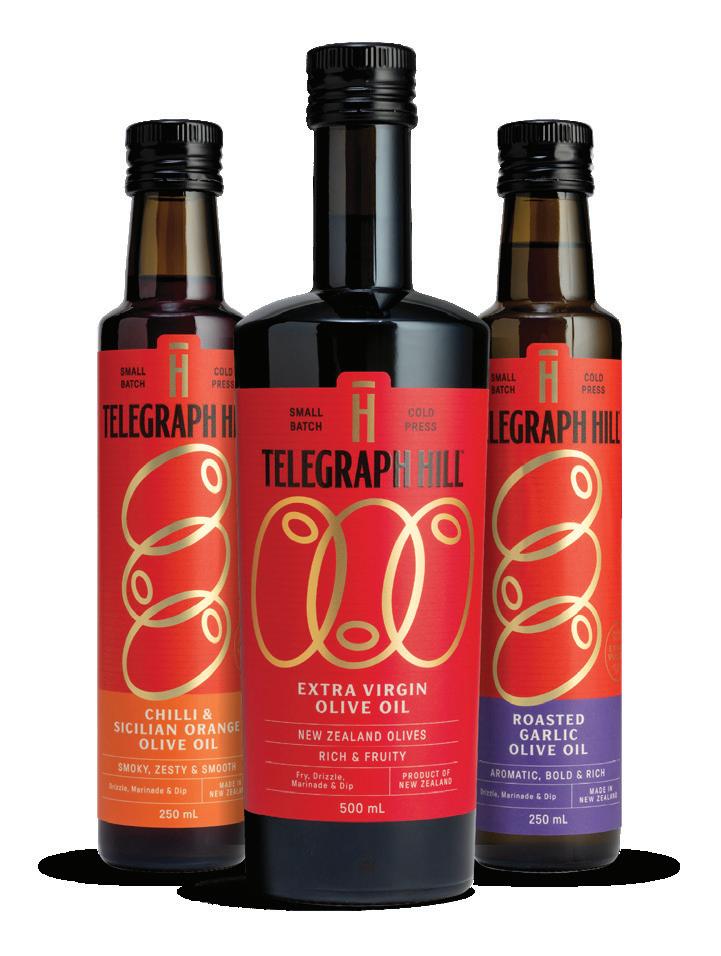
Proudly made in New Zealand, Telegraph Hill’s awardwinning Extra Virgin Olive Oil delivers fresh, grassy and peppery flavour with a vibrant finish.
High in antioxidants and renowned for its health benefits, it’s available in both 250ml and 500ml bottles to suit every kitchen.
Alongside the flagship EVOO, Telegraph Hill offers three flavoured oils: Roasted Garlic - rich and mellow, Truffle - earthy and luxurious, and Chilli & Sicilian Orange - bright with a fiery warmth.
Crafted in small batches to bring restaurant-quality flavour to everyday meals, making it easy to elevate cooking with a simple drizzle.
For more information visit telegraphhill.co.nz





Modern innovation meets trusted heritage in products designed for Kiwi kitchens
Bertolli, the world’s No.1 olive oil brand, has launched two exciting new products into the New Zealand market: Bertolli Air Fryer Spray and Bertolli Dress & Drizz.
These innovations are more than just new formats. They’re a direct response to evolving Kiwi cooking habits, offering convenience, quality and versatility that suit modern, busy lifestyles.
Aligning with Everyday Cooking
Across the country, cooking habits have shifted toward faster, healthier, and more flexible approaches to mealtimes. Consumers want easy solutions that still allow them to prepare fresh, nourishing food at home without lengthy prep or complicated techniques.
Air fryers have become a fixture in many kitchens, enabling quick and healthier versions of classic favourites. At the same time, fresh salads, grain bowls, and simple build-your-own meals have become increasingly popular, particularly among young professionals, busy families, and health-conscious consumers.
Bertolli’s new launches fit seamlessly into these daily routines, offering trusted olive oil quality in modern, practical formats.
“Modern Kiwi cooking is about quick, flavourful solutions,” said a Bertolli spokesperson.
“Air fryers, easy salad dressings, minimal prep; these aren’t trends anymore, they’re everyday habits. Our new products are designed to fit naturally into those routines.”
Bertolli Air Fryer Spray: Crisp, Clean, Convenient
The Bertolli Air Fryer Spray is designed to enhance the air frying experience. Air fryers are now used regularly in New Zealand households, for everything from quick weeknight dinners to weekend snacks, and this product helps achieve crisp, golden results with ease. The spray delivers an even, fine mist, allowing ingredients to cook
evenly and brown beautifully with less oil.
Perfect for kumara and potato fries, roast vegetables, chicken, fish, seafood, and pastries.
Unlike many cooking sprays on the market, Bertolli’s formula is non-aerosol and contains no additives or propellants. It’s a cleaner, more natural option that aligns with how healthconscious consumers prefer to cook.
The simple spray top also ensures minimal waste and consistent coverage, saving both time and effort, exactly what busy households are looking for.
“People love their air fryers because they make cooking faster and cleaner,” said the spokesperson.
“Our spray enhances that experience with the trusted quality of Bertolli olive oil.”
Bertolli Dress & Drizz: Fresh Flavour, Zero Fuss
Alongside the Air Fryer Spray, Bertolli has launched Dress & Drizz, a premium extra virgin olive oil designed for maximum flavour with minimal effort.
As more Kiwis embrace fresh, buildable meals like salads, bowls, and light grilled dishes, Dress & Drizz offers a simple way to finish meals with authentic Mediterranean flavour, no mixing, whisking, or prep required.
Typical uses include: a drizzle over fresh salads, finishing touch on roasted vegetables, topping for warm grain bowls or pasta, elevating grilled meats, fish or plant-based dishes
With its smooth, fruity flavour and velvety texture, Dress & Drizz is perfectly suited to the way New Zealanders are eating now, light, fresh, and flexible.
“Kiwis want food that tastes great but doesn’t take hours to prepare. Dress & Drizz gives them the premium olive oil flavour they love, in a format that fits their lifestyle.”
Bertolli Quality Commitment: A Legacy of Trust
Behind these launches is a 160-year tradition of craftsmanship and care. Founded in Lucca, Italy, in 1865, Bertolli has built its global reputation on authentic olive oil of exceptional quality.
It has ensured that the olive oil quality through a comprehensive and multi-layered process – from farm to bottle and beyond.
• Rigorous olive sourcing and family partnership
• On-farm and mill audits
• Advance laboratory and sensory testing
• Master blending and continuous sampling
• Certification and audits
• Quality assurance
“When shoppers reach for Bertolli, they’re choosing a brand with over a century and a half of expertise behind it. Our products have always been about trust, quality and the joy of good food, and these new launches are no exception.”
This quality promise resonates strongly with New Zealand consumers, who value clean ingredients, authentic taste, and reputable brands.
Both the Air Fryer Spray and Dress & Drizz have been designed to fit naturally into daily cooking, making it easier for New Zealanders to prepare meals that are:
• Faster: Simple, no-fuss products that save time in the kitchen
• Healthier: High-quality olive oil with no additives or propellants
• Flavourful: Authentic Mediterranean taste that elevates everyday ingredients
• Flexible: Suitable for a variety of dishes, occasions, and household types
Whether it’s a quick weekday dinner, a shared weekend lunch, or meal prep for the week ahead, these products make it easier to enjoy wholesome, great-tasting food without overcomplicating the process.
“Our goal is to help people eat well every day without making cooking feel like a chore. These products deliver that balance beautifully.”
Bertolli has always celebrated simple, good food made with quality ingredients. With these two new launches, the brand brings that same Mediterranean philosophy to the way New Zealanders cook and eat today, fast, fresh, and flexible.
Both products are available now in Woolworths supermarkets nationwide and are in the process of going through Foodstuff’s category reviews.
For further information: Bertolli New Zealand Trade Team angus@wilait.com www.bertolli.com
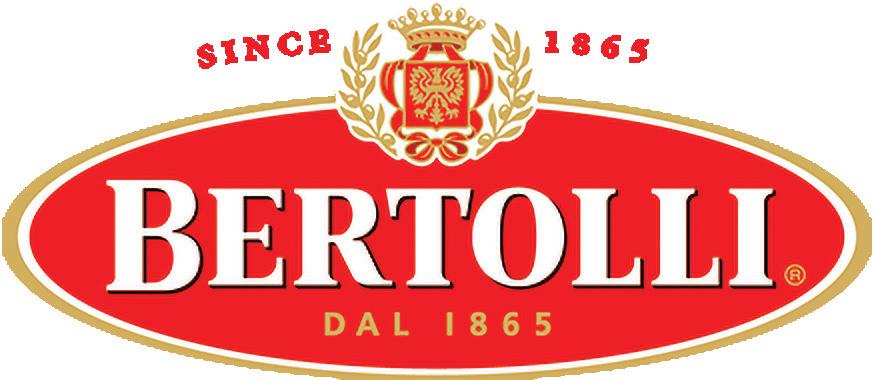
TWO NEW OILS DESIGNED FOR TODAY’S KITCHEN

NEW

BERTOLLI EXTRA VIRGIN DRESS & DRIZZ
CONVENIENT EASY SQUEEZE BOTTLE WITH PRECISE DOSAGE CONTROL
NEW BERTOLLI AIR FRYER OLIVE OIL SPRAY
COOKING OIL SPRAY MADE SPECIFICALLY FOR AIR FRYERS 1st
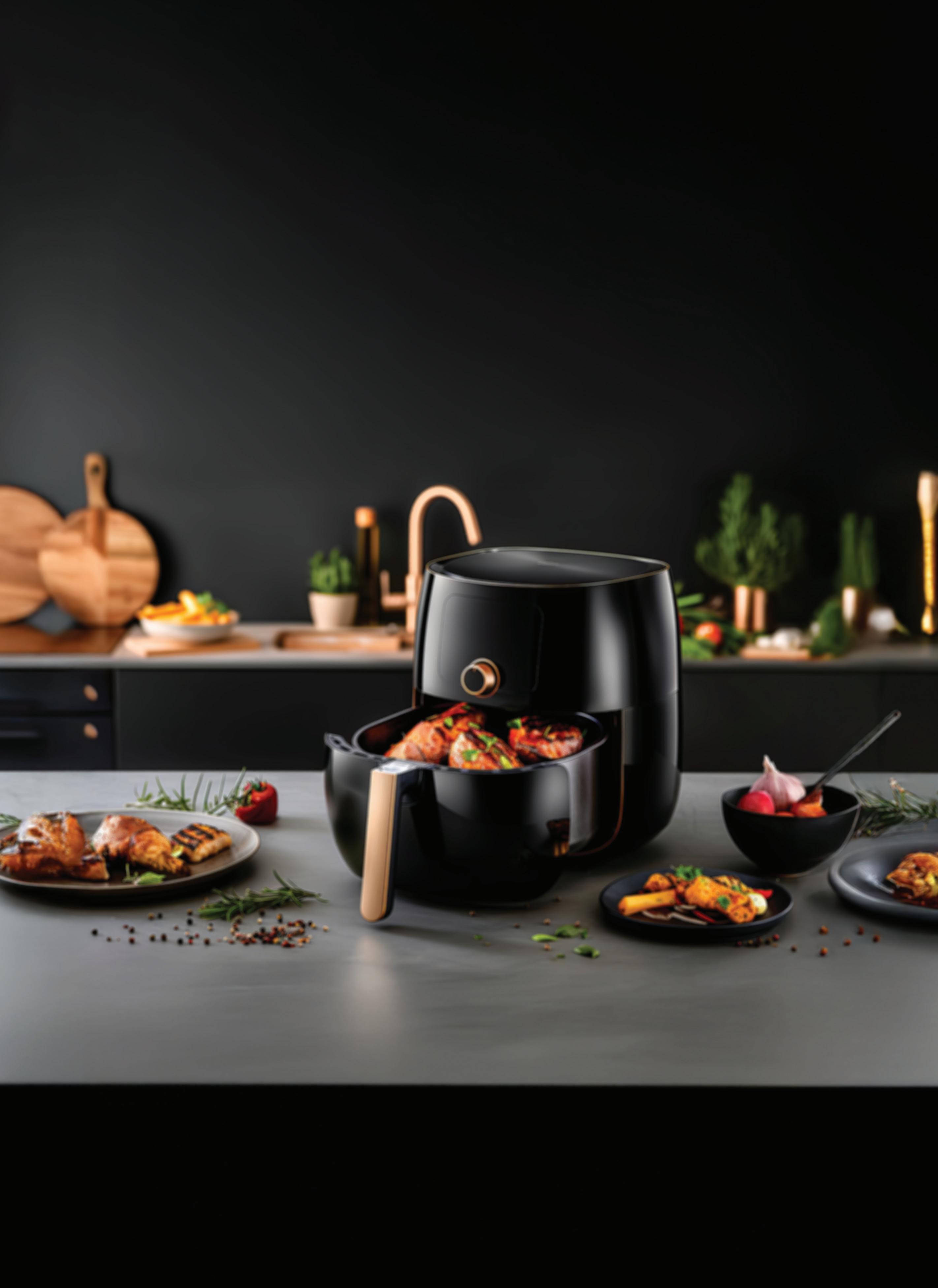
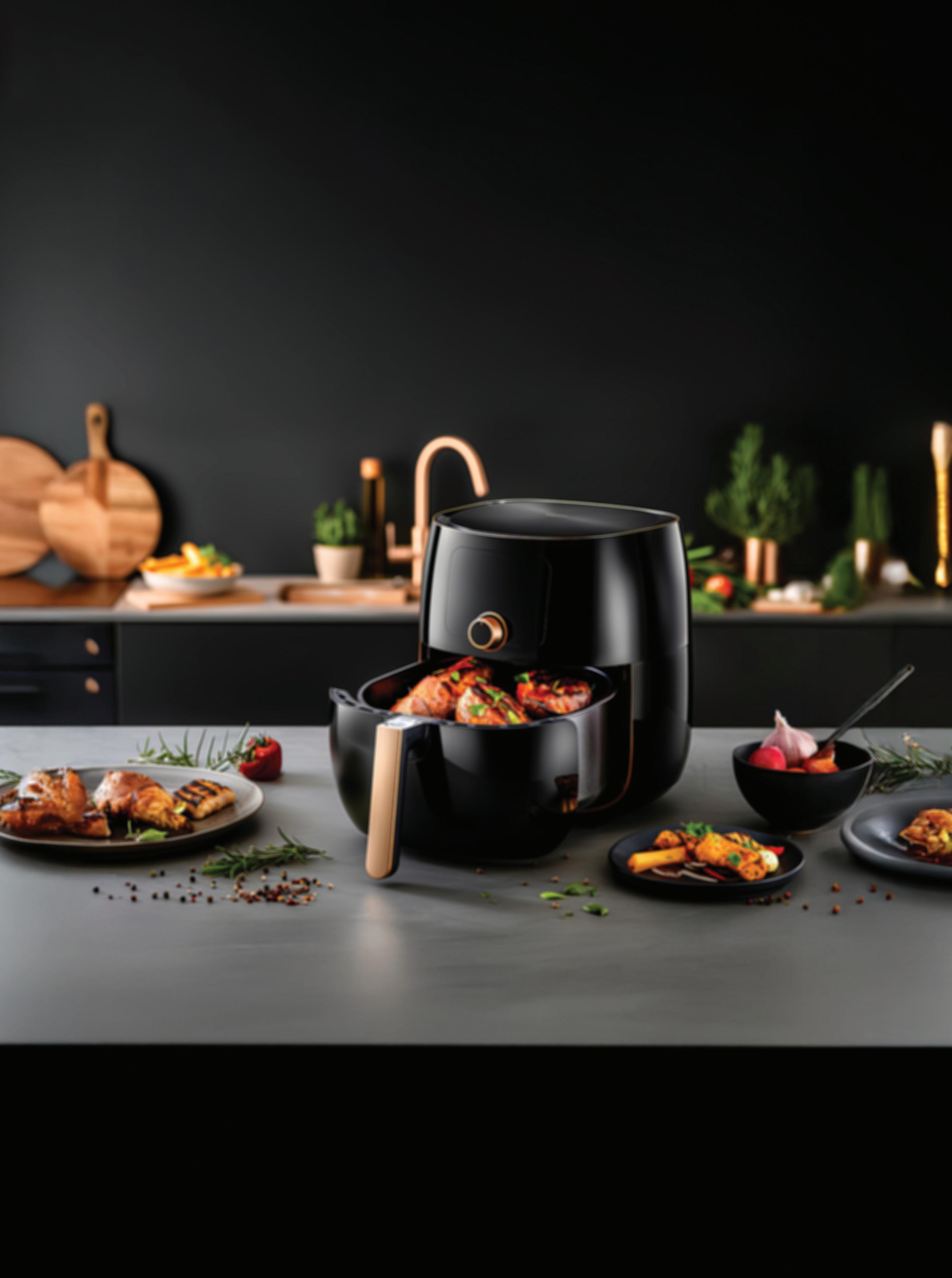

Olive oil has evolved from a specialty ingredient to a trusted everyday essential for Kiwi shoppers. In a market where quality and authenticity increasingly drive purchasing decisions, Lupi Olive Oil continues to lead the way, offering a premium yet accessible range that delivers both flavour and trust.
The brand’s enduring presence on New Zealand supermarket shelves reflects not just market longevity but consumer loyalty. Generations of New Zealanders have used Lupi to elevate their daily cooking, from fresh salads, grilled seafood, to baking and marinades.
A Brand with Proven Heritage
Lupi’s journey began with a simple but enduring promise: to bring authentic, highquality olive oil to everyday kitchens. Over time, that promise has grown into a strong retail presence nationwide, making Lupi one of the most recognisable olive oil brands in the country. Each bottle is crafted to highlight the natural character of the olive oil, delivering clean, distinct flavours that consumers can taste and trust.
A Range Designed for Every Kitchen
Lupi offers a diverse range of olive oils to suit different cooking styles, flavour preferences and price points, making it an accessible premium product for both home cooks and professionals.
• Extra Virgin Olive Oil: the full and fruity flavour makes extra virgin olive oil ideal for salad dressings, marinades, topping pastas, soups, sauces and bread dipping. This is the one to use as a finishing drizzle.
• Pure Mild Taste Olive Oil offers a smooth and balanced flavour that is highly versatile for roasting, grilling, stirfrying, as well as soups and sauces.
• Extra Mild Taste Olive Oil is an oil that will not overpower delicate foods and is great for high-heat cooking like frying, baking and sautéing.
All Lupi olive oils are naturally cholesterolfree, rich in heart-healthy monounsaturated fats and a source of antioxidants (Extra Virgin), making them a smart and wholesome addition to everyday meals.
At the heart of Lupi’s reputation lies an unwavering commitment to quality, built on rigorous standards that protect the integrity of every bottle. This is not just an olive oil – it is the result of careful craftsmanship, sustainable sourcing and precise control from grove to shelf.
Each batch is subject to strict quality testing and sensory evaluation, exceeding legal requirements. The brand champions sustainable sourcing and uses recyclable glass packaging to align with growing consumer demand for ethical products.
Its long-standing commitment to freshness, flavour, and sustainability resonates with Kiwi consumers seeking products they can rely on daily.
“For us, it’s all about integrity, from the grove to the bottle. Kiwi shoppers know and trust Lupi because we never compromise on quality. Our oils are crafted to bring out the best in every dish, whether it’s a simple salad or a family feast,” said brand spokesperson, Lupi Olive Oil.
New Zealand consumers value freshness, simplicity, and authenticity. Whether it’s drizzled over salads, paired with freshly grilled snapper, or whisked into a lemony vinaigrette, Lupi olive oil fits naturally into everyday local cooking.
Its versatility also makes it a highfrequency pantry item that fits seamlessly into New Zealand food culture. Available in all leading supermarkets.
For further information:
Lupi New Zealand Trade Team angus@wilait.com https://lupi.co.nz/
Lupi Olive Oil - Trusted by Kiwis, crafted for quality.





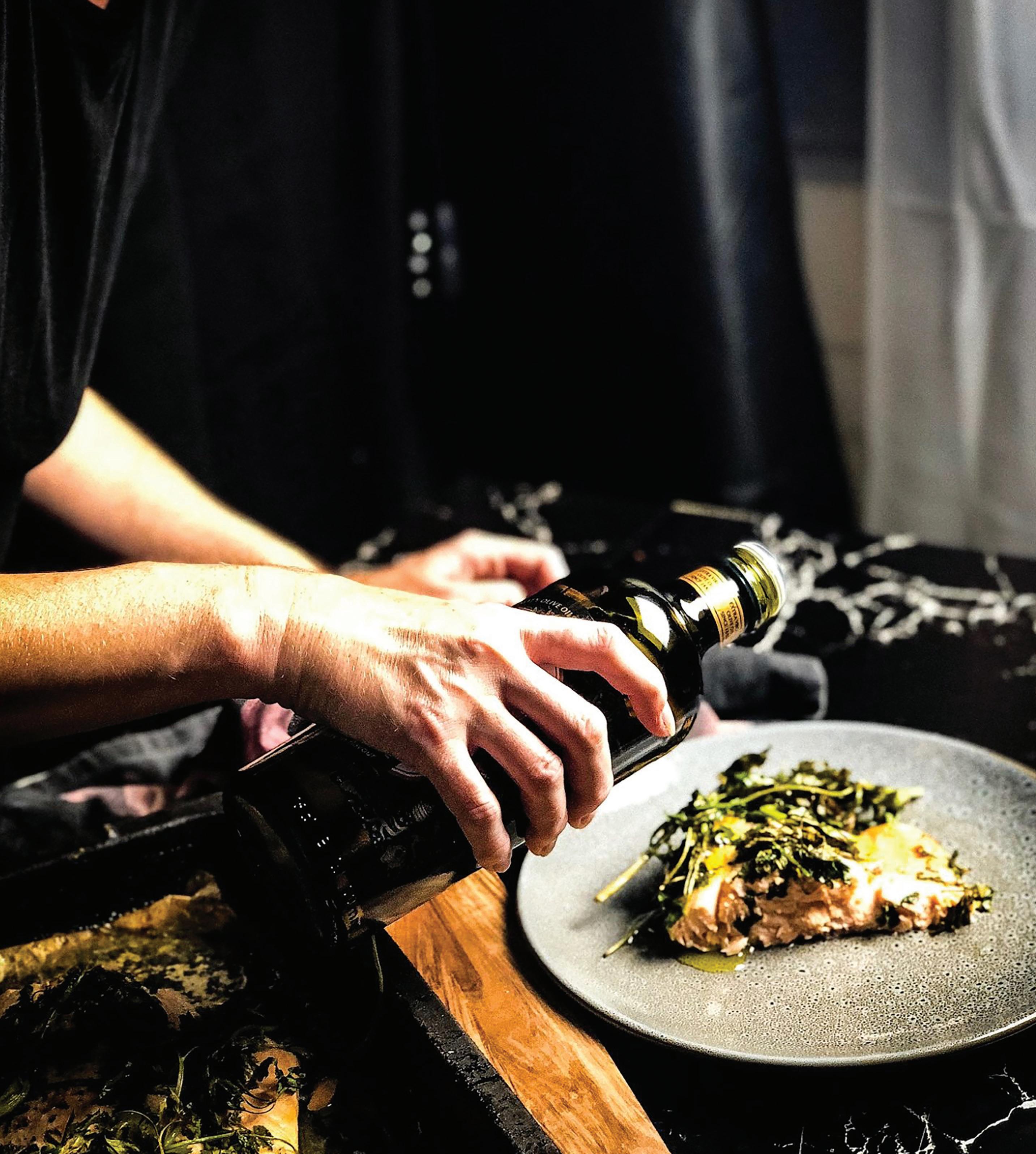





Hailing from the UK, Andrew Liley, Director of Juno Olives, had qualified as a doctor and was working in the industry for 25 years before he decided to move into New Zealand’s primary sector.
Of the many things he looked into, growing olives was a good fit for him, as the potential to produce a product with proven health benefits was a strong incentive.
This season has been great for Liley, as Juno Olives has produced more olive oil than in any other year, which Liley said was a testament to the changes made to land and tree management over the last five years.
“Like anything in farming, you make a change on a hunch but may not see results for several years afterwards. Sustainability is not all about what you do day to day, but what you can achieve over a year, a decade and longer,” he said.
“We are trying to be increasingly sustainable and biodynamic. I’m certainly of the opinion that we don’t want to be poisoning the ground we have been given to care for, and if we look after it, the olive trees will be all the better for it.”
At Juno Olives, the canopies have been managed to improve airflow and sunlight, reducing disease pressure and, in turn, spraying frequency. All pruning and solid matter is done after pressing and is ultimately returned to the grove.
Customer feedback has shown Liley that people seemed generally amazed by what was involved in growing olives to produce the best-quality product.
They have also been quite surprised by how different the oils taste depending on the olives and by how different Juno Olive oils are from the mass-produced olive oils. Additionally, the Tararuas' landscape and free-draining soil made it ideal for olives and for daily grove management.
Although the pressing process is the same for each variety, by selecting at the optimal time and keeping each variety separate, Liley hoped to showcase each olive oil's individuality.
“The varieties themselves vary in size and shape, the trees are all different, and the oils they produce each have their own individual character.”
His favourites vary year on year, but this year Liley said that the Picual and Moraiolo had produced very nice, balanced oils, with the former having just won an award.
Liley also enjoyed the production of Agrumatos, where the flavouring fruit or herb is actually put into the press with the olives. This produces a much more rounded oil flavour but is fraught with risk, as one can never be quite sure what one will get due to year-on-year variation in olives and fruit.
“When you get it right, it produces some real winners.”
Looking ahead, Liley said he would be focused on gradually reshaping canopies to suit mechanical harvesting, reducing the need for spraying and producing awardwinning olive oils. n




Consumers around the world enjoy edible oils, but as concerns rise about health and sustainability, the oils consumers choose have changed, prompting food manufacturers to look for cleaner options.
Although there are many edible oils, seed and nut oils have been especially popular, with sunflower oil being the most widely used, followed by canola, aka rapeseed oil.
At the same time, some oils have become less popular due to concerns about nut allergies, which has led some consumers to avoid certain nut oils. Since 2020, the use of fish oils has also decreased because of taste issues and a consumer shift to plantbased options.
Algae oil, avocado oil, and rice bran oil were among the other popular alternatives to traditional oils. Another reason for alternatives has been rising prices attributed to a higher demand, limited exports, and climate-driven disruptions.
Consumers no longer view oil just as an ingredient in food products. They see it as a reflection of the brand’s integrity, the product’s quality, and its healthiness. Oil ingredient trends indicate that more consumers have become mindful of their choices and have chosen sustainable alternatives to traditional seed and palm oils.
Oils linked to health risks or environmental harm are being avoided, with young millennials discussing healthy cooking oils, oil-based products, and recipes online. Sunflower oil can be a healthy option as high-oleic sunflower oil is full of heart-friendly monounsaturated fats. On the other hand, refined sunflower oil contains a lot of omega-6 fats, which can lead to inflammation if eaten in large amounts.
Olive oil, particularly extra virgin, has been considered a good source of monounsaturated fats and antioxidants, associated with heart health benefits,
reduced inflammation, and protection against chronic disease.
Coconut oil contains medium-chain triglycerides, which can be quickly absorbed and turned into energy. They help speed up metabolism, help with weight management, and increase good cholesterol for heart health.
There has also been growing attention toward the health benefits and claims of oils used in cooking and packaged foods, with a shift away from palm and seed oils. Oil ingredient trends reveal that consumers choose more sustainable options such as avocado, algae, and fruit-based oils.
Olive oil and vegetable oil are often mentioned in online discussions around the world as they are strongly linked to health and wellness and widely used in cooking across different cultures. Both oils are also easy to find in supermarkets and frequently appear in content from influencers and home cooks, making them trusted staples and obvious ingredients in daily digital food conversations.
Therefore, brands have also replaced palm oil to make palm oil-free claims. This is especially true in Europe, where 82 percent of all palm oil-free claims can be found. When replacing palm oil, sunflower oil has become the most common alternative.
However, palm oil is still a popular choice for many food companies because it is versatile and affordable compared to higher sunflower oil prices. Sustainably sourced palm oil is also becoming more significant, with sustainably produced palm oil growing at a 9 percent CAGR in food and beverage launches over the past five years.
About 25 percent of food and beverage launches worldwide include edible oils. Seed and nut oils remain a common

About 25 percent of food and beverage launches worldwide include edible oils. Seed and nut oils remain a common commodity, exhibiting a CAGR of four percent over the last five years.
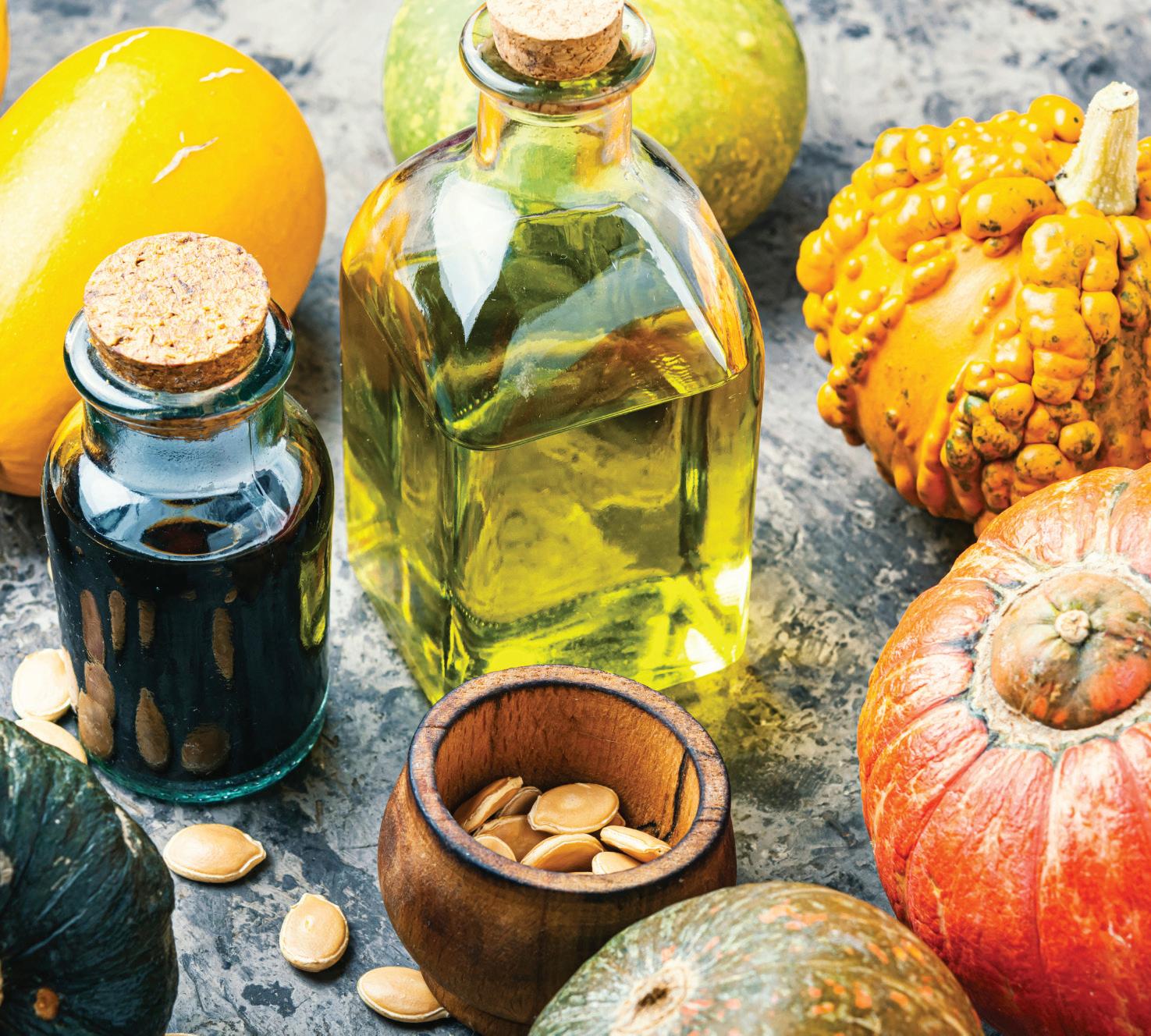
commodity, exhibiting a CAGR of four percent over the last five years.
Oil ingredient trends indicate that fruit and legume oils have experienced similar growth, reflecting rising demand, with mixed oils being the fastest-growing type of oil ingredient. In Asia, sesame oil has regained popularity because of its traditional flavours. As more people around the world try Asian food, the demand for sesame oil has been increasing rapidly.
As the demand for clean label options grows, brands can improve their products by using affordable oils and enhance their image by replacing traditional options like partially hydrogenated seed oils with healthier choices, such as avocado oil instead of vegetable oil for chips. Brands can remain competitive by introducing oil-based products that align with plant-based, gutfriendly, and wellness trends. n






A unique research project is investigating the impact of a changing climate on the quality of New Zealand’s olive oil.
When Cyclone Gabrielle swept across New Zealand in early 2023, it had a devastating effect on crops around the country. Its arrival signalled a shift to an era where extreme weather events are becoming increasingly normal.
Case in point: in March of this year, the government declared an official drought for the Greater Wellington, ManawatuWanganui, Taranaki and Northland regions. More recently, in June, residents of Wairoa, Hawke’s Bay, entered a State of Emergency after severe flooding struck their small coastal town.
Cyclone Gabrielle got Dr Danaé Larsen thinking. The food scientist and senior lecturer at the University of Auckland’s School of Chemical Sciences wondered: just how is the changing climate impacting the chemical and sensory qualities of certain foods?
Dr Larsen’s interest in science and food began as a child, experimenting in the
kitchen. With a background that includes a PhD examining lipids in New Zealand king salmon, and co-founding Swiss-based start-up HPP Schweiz, which provides highpressure processing for food preservation, she is now group leader of the University’s Larsen Lab.
Since 2022, she and a team of postgraduate students have been focused on sensory science. They have studied the aroma compounds of food pairings, how smell impacts taste, the link between food texture and satiation, and now, the effect of climate change on the taste and chemical composition of olive oil.

“The olive harvest happens, depending on the region in New Zealand, from March, April, through to June, July,” Dr Larsen explained.
“In 2023, when the olives were already on the trees, we had a very wet summer in the North Island, including Cyclone Gabrielle, while the South Island was pretty dry. I wondered if there would be a noticeable
difference between the olive oil produced in the South Island versus the North Island.”
She is the inaugural recipient of the Edwards Olive Oil Research Fund, an endowed gift from international olive oil judge and former olive oil producer Margaret Edwards. To start, she and her team studied historical weather data. This helped them to build a picture of how rainfall, sunshine hours, air and soil temperature have behaved over time, which they can use to identify trends as the project progresses.
They then analysed single-variety olive oil from the 2023 harvest taken from different areas around the country. Regions ranged from Northland, South Auckland, Waiheke Island and Wairarapa in the North Island to Nelson and Central Otago in the South Island.
In the lab, they chemically mapped the olive oil’s lipid and polyphenol profiles. The latter is particularly important when it comes to flavours in olive oil.
“Polyphenols are compounds that can directly relate to taste. The characteristic bitter or pungent taste of some olives, the green, leafy taste of olive oil; these things are thought to be affected by rainfall,” said Dr Larsen.
“If there’s excessive rain, there are generally far fewer polyphenols in the fruit.” In theory, fewer polyphenols of particular types should equate to olive oil with a less bitter and green, or different, flavour altogether.”
So, what do the project’s early results reveal? Although still in its infancy, preliminary findings show that the polyphenol profile of single-variety olive oil from the 2023 harvest does differ between regions, in particular, between those where rainfall and sunlight hours differed the most.
The team has also identified differences in the olive oil’s fatty acid content and will next examine why this might be. In 2025, they will continue to investigate olive oil’s sensory properties to determine whether the changes they have detected translate into different flavour profiles. To do this, they will use sensory panels and, for the first time in New Zealand, an electronic tongue.
It's an exciting start, said Dr Larsen, who hoped their work would eventually help to future-proof the local olive oil industry.
“This is really important because, as climate change unfolds, there will probably be some areas of New Zealand that historically have grown olives that may not be as suitable anymore.”
By establishing general trends in weather and the climate’s impact on olive oil quality, they aim to indicate what might happen to the chemical and sensory properties of olive oil as time goes on, so that growers can adapt.
There’s also potential to elevate New Zealand’s olive oil further on an international level. If scientific evidence can provide growers with information that enables them to enhance their product’s
Polyphenols are compounds that can directly relate to taste. The characteristic bitter or pungent taste of some olives, the green, leafy taste of olive oil; these things are thought to be affected by rainfall,
composition and sensory properties, they could garner recognition on the world stage, much like the wine industry.
“We have so many growers now. We want to show them that, if you do each process the right way, if when you grow and mill the olives you really look after them, from the tree all the way through to the olive oil, you’re going to end up with a premium product. It can be up there with Sauvignon Blanc from Marlborough.”
The story was first published in the University of Auckland’s Donor News publication.





New data from SPINS revealed powerful momentum for Seed Oil Free Certified products in early 2025.



Seed Oil Free Certified™, the world’s first certification for products made without seed oils, has entered a strategic data partnership with SPINS, the leading provider of data and analytics for the wellness-focused CPG industry.
This collaboration provided the first empirical look into a rapidly emerging consumer preference: the growing demand for products made without industrial seed oils.
Newly released data from SPINS highlighted the surge in demand for Seed Oil Free Certified products during the first quarter of 2025:
• +216 percent average sales growth compared to Q1 2024
• +410 percent growth over the most recent 12-week period
• Strong performance across both natural retail (+124 percent) and conventional retail (+225 percent) channels
These results reflect a shifting marketplace, where shoppers are increasingly seeking transparency in product formulation, particularly around highly processed seed oils. A recent survey found that 28 percent of U.S. consumers are actively avoiding seed oils, driven by interest in simpler ingredients, less industrial processing, and greater transparency.
“Consumers are making increasingly deliberate decisions about the food they buy, supporting brands that are transparent, mission-driven, and aligned with their values,” said Jonathan Rubin, founder and CEO of the Seed Oil Free Alliance.
“Seed Oil Free Certification is resonating with today’s values-oriented shopper. We’re seeing strong growth across certified brands, and it’s clear this is a trend to watch as more companies prioritise straightforward, minimally processed ingredients.”
Today’s consumers are not just reading labels, they're analysing them. Ingredient transparency has become a key driver of purchasing behaviour, with more shoppers actively seeking products that use traditional cooking fats in place of highly refined seed oils.
Third-party certifications that verify ingredient sourcing and processing methods are playing an increasingly important role in building trust on the shelf.
“Displaying the Seed Oil Free Certified Seal on our packaging helps customers identify Daily Crunch as a product aligned with their values,” said Laurel Orley, CoFounder of Daily Crunch.
“We’ve seen firsthand the positive impact it has had on our brand.”
The brands tracked in SPINS’ Q1 2025 analysis all received certification after Q1 2024, suggesting this growth is not
simply part of a broader category trend but the direct result of certification’s impact on visibility, formulation clarity, and consumer trust.
Seed Oil Free Certified brands have reported stronger buyer interest, driven by oil quality and formulation purity, increased shelf velocity from health-conscious, label-reading shoppers and greater product differentiation in crowded snack and packaged food categories.
Industrial seed oils such as soybean, canola, sunflower, and corn oil were virtually nonexistent in the American diet at the start of the 20th century. Today, they account for an estimated 20 percent or more of total daily caloric intake in the U.S., mainly due to their use in packaged foods, restaurant meals, snacks, and common cooking oils at home.
Initially embraced for their cost and shelf stability, seed oils have more recently come under scrutiny from consumers concerned about industrial refining, high omega-6 content, and the prevalence of highly processed ingredients in modern diets.
In response to this shifting awareness, Seed Oil Free Certified was launched in 2023 to give brands a clear and verifiable way to demonstrate oil quality and formulation integrity. The program has grown rapidly, with dozens of certified brands across snacks, sauces, frozen meals, and pantry staples now displaying the certification seal. n




What began as a pandemic hobby has evolved into sustained market growth, driven by demand for natural, fermented, and gutfriendly baked goods.
According to Future Market Insights (March 2025), growing consumer interest in healthy, artisanal baking has significantly lifted sourdough’s profile.
“Gut health has become a growing area of focus for health-conscious consumers. Sourdough's ability to stay relevant on menus and shelves reflects this interest,” said Nandini Roy Choudhury, Client Partner at Future Market Insights.
The widespread availability of sourdoughbased products across supermarkets and e-commerce has made them more accessible than ever, helping drive category expansion.
Innova research in the Asia Pacific region (April 2025) also revealed that bread and bread products have continued to diversify through innovation, with white, whole, sourdough, millet, oat, and rye varieties all gaining ground.
Trends showed that one in five

consumers now enjoyed bread products as snacks, highlighting their versatility and convenience. Recently, new product launches have also emphasised traditional, limited-edition, natural, no-trans-fat, and low-sugar positioning.
Handcrafted products have increasingly driven brand appeal, with many consumers in the Asia Pacific preferring homemade or handmade options, drawn by the sense of authenticity.
Brands have also met consumer demand for novelty and excitement through bold flavour innovations. Dessert-inspired, sweet-and-spicy, and cross-category flavour mashups are trending, with the top five flavours in bread and bread products identified as milk chocolate, cheese, strawberry, garlic, and red bean.
In September 2025, when Taylor Swift mentioned her love of baking homemade sourdough bread and proposed the idea
Heights podcast, while announcing her new album, fans quickly embraced the trend.
Recognising the opportunity, Pillsbury soon launched a Funfetti Sourdough Bread Mix, offering fans an easier way to recreate the trend at home. The kit promised a loaf that blended the classic tangy taste of sourdough with a subtle touch of sweetness, creating a bread that’s joyful and fun.
While many home bakers have discovered how challenging sourdough can be to master, pre-mixed kits like this provide a shortcut, reflecting a broader movement towards convenience and creativity in baking.
Seasonal and limited-edition offerings will continue to capture consumer attention by delivering fun experiences. At the same time, plant-based and dairy-alternative formulations, as well as floral-infused breads and other creative inclusions, have emerged and will appeal to adventurous consumers. n
Say hello to Venerdi Gluten Freedom Seedy Sourdough Bread, it’s flipping the script on bland bread. This beauty comes lightly sprinkled with seedy goodness, adding just the right amount of crunch and flavour to every bite - it's ready to level up your day! Who knew seedy could be something to look forward to?
Vegan friendly and free from gluten, dairy and soy, but you wouldn’t know it and that’s the point.
Now available at New World, PAK'nSave and Woolworths.
For more information, contact info@venerdi.co.nz or visit www.venerdi.co.nz








Founded on circular economy best practices, Rescued is innovating, collaborating, educating and advocating for a better, more sustainable food future.
Rescued Founder Diane Stanbra said that collaboration is how the problem of good food being unnecessarily wasted can be solved.
From its first partnership with NZ Hot House in May 2023 to those with Woolworths and KiwiHarvest, as well as with Remarkable Tortillas, Rescued has continued to give products a new shelf-life and endless manufacturing applications.
The latest collaboration with Te Arikinui Pullman Auckland Airport saw ‘aftersqueezed’ oranges from the guest breakfast buffet going full circle as Rescued used the oranges to create marmalade for Pullman guests as an in-room guest amenity that can also be purchased as a unique souvenir with a story.
Bread, one of the most wasted food products globally, has also been dehydrated and milled and turned into Rescued Bread Flour. Another valuable by-product of the milling process is breadcrumbs.
“I was shocked to learn that breadcrumbs aren’t made from leftover bread anymore. Most breadcrumbs are now made from a new dough, which is crazy when you consider that perfect bread
is being wasted,” said Stanbra.
“In addition, many breadcrumb options on New Zealand shelves are imported. Really unnecessary when we can do it using bread.
Rescued Bread Flour from bread is the most innovative, and it’s used in world-first products. It’s also the most scalable, with the potential to end bread waste globally.”
Stanbra added that gin powder from spent juniper berries, after making gin, has been a very popular ingredient with chefs. The flavour profile is extraordinary, and uses are endless. We’ve made syrups, sodas, ham glaze, marinades, gin salt, gin sugar and gin butter.
Another favourite of Stanbra’s is Rescued tomato water molasses, a by-product of a by-product, and it is on the menu at SkyCity.
Rescued also complies with rigorous, independently audited MPI Food Control Plan and Upcycled Food Association requirements, which control and verify the materials upcycled. Customer demand has been another key factor in determining what the organisation upcycles.
Currently, Rescued has projects underway with End Food Waste Australia and FoodBank Australia, and has participated
in a project with NYU Stern and the Ellen MacArthur Foundation around making the business case for sustainability investment.
Stanbra added that upcycling offers retailers, manufacturers, growers and farmers an opportunity to turn loss into value. Consumers can amplify positive environmental, economic and social impact by choosing sustainable and upcycled products and ingredients and truly understanding where products come from and how they have been made.
“Next is scale up. We can reduce the costs and consequences of food waste and improve food affordability and food security with a globally recognised and financially viable solution. We have a unique opportunity to position New Zealand as a leader in the USD 54 billion global upcycled food market,” she added.
“We can grow New Zealand’s economy, creating new jobs, additional revenue streams for growers and farmers, bringing new infrastructure, IP, innovation, and investment opportunities to market and amplifying the positive impact on a global scale. Who wouldn’t want to be part of that?” n


The bakery aisle is a treat for the senses with consumers eager to sample breads, filled rolls and artisanal baked goods. Yet, behind enticing aromas and attractive packaging lies a complex legal landscape that supermarket retailers and suppliers must tread carefully.
Intellectual property protections like trade marks and copyrights are important tools for safeguarding brand identity, preventing costly disputes down the road.
One of the most telling recent examples involved a trade mark infringement dispute between Brisbane-based Blackstar Coffee Roasters and Sydney’s Black Star Pastry. Blackstar Coffee successfully asserted its rights against the use of the “Black Star” name by the pastry shop, illustrating a crucial principle: overlaps in brand names even in connected product categories like coffee and baked goods can trigger expensive and reputation-damaging litigation. For supermarket buyers and bakery suppliers, this case is a reminder to conduct thorough trade mark searches and
register distinctive brand elements early to avoid conflicts that can disrupt supply chains and shelf presence.
Copyright issues are also rising in the bakery sector, especially concerning recipe protection. The recent Maehashi controversy spotlighted the challenges in legally protecting recipes themselves. In April 2025, Australian food blogger Nagi Maehashi of RecipeTin Eats publicly accused Brooke Bellamy, author of the cookbook "Bake with Brooki," of plagiarising her caramel slice and baklava recipes, claiming nearidentical wording and structure beyond common ingredients. Bellamy denied the allegations, stating she developed her recipes independently over several years and provided dated evidence of prior use. While copyright law in Australia protects the expression of a recipe's writing, it does not protect the underlying idea or

functional elements, proving infringement is challenging. Bellamy offered to remove the disputed recipes from future editions, reflecting an effort to resolve the dispute commercially without admitting fault. The case sparked broader debate about the limits of copyright protection for recipes, where ethical concerns over plagiarism often intersect with legal questions, highlighting the need for trade secrets and collaboration to protect culinary creations in the digital age.
Can recipes be protected?
The distinction in copyright law where recipes and ingredients are typically not copyrighted, but the creative expression surrounding them may be, complicates
how supermarkets and suppliers negotiate product development and protect proprietary knowledge. Embracing trade secrets and fostering ethical collaboration throughout the supply chain remain strategies to manage these risks, as courts often have limited appetite for protracted recipe ownership battles.
Filled bread rolls, buns and related products should be carefully classified and registered under appropriate trade mark classes, avoiding generic or descriptive marks that offer little protection. Early registration under national and international protocols, alongside vigilant monitoring of new trade mark filings, enable brands and supermarkets alike to uphold exclusive rights that sustain competitive advantage.
Here are four practical ways bakery brands can strengthen their IP strategy:
• File in the right classes: Baked goods fall under Class 30, but don’t stop there. Think about related goods (such as jams, jellies, compotes, which fall in another class), packaging, retail services or expansion into cafes.
• Be unique: Descriptive marks like “Golden Crust” or “Wonderful White” may offer little protection. Inventive or unusual names stand taller.
• Register early and widely: Use systems like the Madrid Protocol to secure rights overseas before your competitors do.
• Monitor the market: Watch the trade marks register and marketplace. Don’t let a competitor sneak in with a confusingly similar brand.
supermarkets IP guardians?
For supermarket retailers, protecting and leveraging bakery-related intellectual property involves proactive risk management at every stage from supplier agreements to consumer education. Ensuring that bakery suppliers have solid trade mark registrations and clear rights to use brand names prevents inadvertent infringement. Meanwhile, educating consumers about authentic branded bakery products enhances loyalty and differentiates offerings in a crowded marketplace.
How can retailers thrive?
Staying ahead of legal pitfalls will be as critical as product innovation. By baking legal clarity into their strategies, supermarkets and their bakery partners can protect their brands, reduce legal disruptions, and nurture consumer confidence in the freshness and authenticity of their bakery offerings.
This informed approach will ensure supermarkets remain competitive and trusted leaders in the growing and highly competitive bread and baked goods market.






Hot off the oven trays, Woolworths has served up a fresh slice of Kiwi creativity with its new range of bakery treats.
Celebrating homegrown talent and stars of their annual Baker of the Year competition, the fresh, seasonal spread is proving a real winner with shoppers.
Three talented bakers from across New Zealand have seen their winning recipes rise from kitchen creations to supermarket staples, with their range in 158 Woolworths stores nationwide.
From Dargaville, Karli Colmer-Cornish has baked up a nostalgic nod to New Zealand’s favourite breakfast combination with her Mitey Cheese Scroll, a soft, savoury swirl layered with cheese and our iconic salty spread.
In Feilding, Tiffany Corlett has turned

a party staple into a bakery sensation. Her Cheesy Onion Pull Apart has reimagined the beloved Kiwi dip found at all good Kiwi gatherings, complete with gooey, cheesy-onion filling woven through soft, buttery bread.
Meanwhile, down south in Amberley, Kyle Vandevondervoot has given the humble spud a starring role. His Potato Bread range uses potato dough for a soft, springy texture that rivals brioche. It’s the perfect pairing for burgers, sliders, or simply slathered with lashings of butter.
With new breads, pull-aparts, pinwheels and even a Cinnamon Swirl Banana Bread joining the line-up, there’s a savoury morsel or sweet treat to suit every taste. n





Adrienne Begbie Managing Director, Prospa NZ
In the fast-paced world of food and beverage, businesses need a financial partner that can keep up. Whether an unexpected expense or a sudden opportunity, that’s precisely what Prospa’s Line of Credit is for.
“Think of it as your business' on-demand cash reserve.
You get a flexible pool of funds ready to go whenever you need it, and you only pay interest on the money you use,” said Prospa NZ, Managing Director, Adrienne Begbie.
“It’s perfect for managing the day-to-day of your business, from covering seasonal cash flow gaps to those unexpected expenses. It gives you the ultimate flexibility, putting cash at your fingertips whenever you need it.”
When it comes to financing, one size doesn't fit all, and Prospa NZ offers a range of flexible options. It has replaced the slow, complex processes of traditional lenders with a streamlined, fast, and flexible approach.

Begbie said most of its customers preferred easy automatic weekly repayments, but they can also make extra payments or pay off their balance early to save on interest.
“Whether it's a cash flow issue, a billing mix-up, or something else, we can often work out a flexible solution, like a temporary payment plan or repayment adjustment, to get you back on track without the added stress.”
Prospa NZ has been a dedicated partner to New Zealand's small business community for 10 years, and has seen firsthand how resilient they are. The team provides personalised support to help businesses navigate unique challenges and opportunities.
Begbie added that the last few years have been a real test, with businesses navigating economic uncertainty and rising costs, and those who've made it through should be incredibly proud.
“We know that businesses, no matter how successful, will always need fast access to working capital to seize opportunities, buy new stock, or cover a short-term gap.” n

As one of New Zealand’s oldest financial services companies, Lock Finance has been helping businesses across New Zealand and Australia since 1889.
Still proudly New Zealand-owned and operated, all decisions have been made locally, ensuring clients have direct access to experienced financial expertise when they need it most.
With API technology integrated with platforms like Xero and MYOB, Lock Finance can upload client invoices and provide immediate funding against them, giving businesses fast, reliable access to working capital.
Collections are managed with equal care. Many clients prefer to retain collection activity themselves, with payments directed into a trust account to offset borrowings, though Lock Finance can also manage collections directly if required.
Relationships are maintained at both an operational level, through regular
contact with client admin teams, and at a management level, with ongoing meetings to ensure smooth operations.
What sets Lock Finance apart in today’s funding landscape is its flexibility and deep industry experience.
“Our team is probably the most experienced in the industry, and we don’t just look at things from a standard banker’s point of view,” said Craig Brown, general manager of Lock Finance. n






Anuga broke all previous records with its 2025 edition, as over 8,000 exhibitors from 110 countries showcased their products in Cologne this October.
More than 145,000 trade visitors from over 190 nations took advantage of the opportunity to discover innovations, experience trends, and establish international business contacts.
The trade audience was especially strongly represented from Great Britain, Italy, the Netherlands and Spain.
Outside Europe, Brazil, China, Japan, Canada and the USA were among the top nations.
With a 94 percent share of foreign exhibitors and 80 percent share of visitors from abroad, and with its ten trade shows, Anuga impressively reinforced its position as the undisputed global platform for the F&B industry.
The visits of Alois Rainer, the German Minister of Agriculture, Food, and Regional Identity, and Miryung Song, Minister of Agriculture, Food, and Rural Affairs from the Republic of Korea, as well as numerous international delegations, also underscored the high level of political interest in the trade fair.
"Anuga impressively demonstrates the central role it plays for the international food industry: It is a showcase for the success of an entire sector and a key driver of billions in sales,” said Gerald Böse, President and Chief Executive Officer of Koelnmesse GmbH.
“The global food industry is one of the
Continued on pg. 50





Continued from pg. 49
most important growth drivers worldwide. This strength becomes tangible at Anuga; it underscores the innovative power and international significance of the sector.”
Partner country Korea: "Flavour Meets Trends"
The appearance of the partner country, Korea was a special highlight of this year's trade fair. Around 100 exhibitors presented the culinary diversity and innovative strength of the country, from fermented classics like kimchi and gochujang, through to modern food tech solutions. Guided Tours, tastings, and cultural brought Korea's cuisine to life for the trade audience.
"This year's Anuga brought K-food and global food trends together. The result was numerous successful meetings between important buyers and the establishment of new business partnerships. This demonstrates once again why Anuga is the central platform for the global food trade," said Bong Jun Yoo, Director of the Korea Food Industry Association (KFIA).
Trends, talks and tastings: An event programme with added value
Anuga successfully brought politics, business, research and the industry together, which was particularly visible on the new Anuga HORIZON Stage.
International experts, such as Edwin Bark (Redefine Meat), Hector Freitas (LIVEKINDLY Collective), and Dr Giuseppe Scionti (Novameat), provided insights into alternative proteins, sustainability, food tech, and vertical farming. Supported by partners such as BALPro, ProVeg, Vegconomist, DLG, Lidl and REWE, the dialogue between politics and business was promoted in a targeted manner.



The new trade show Anuga Alternatives celebrated a successful premiere in the immediate vicinity.
Anuga has once again presented itself as the leading global trade fair for food and beverages. Particularly in today's era of protectionism and global tension, the trade fair has set a strong signal for international dialogue and trade,
"Anuga has once again presented itself as the leading global trade fair for food and beverages. Particularly in today's era of protectionism and global tension, the trade fair has set a strong signal for international dialogue and trade,” said Björn Fromm, President of the German Association of the Retail Grocery Trade (BVLH).
The Anuga Trend Zone was a further highlight. Together with the knowledge partners, Innova Market Insights and Euromonitor International, the Stage provided in-depth analyses on global food & drink trends, sustainability, plant-based food, as well as health and wellness.
The Anuga Organic on Stage focused on organic, plant-based food and sustainability. Among others, the highlights included the Organic Trade Academy's market discussion with the Minister for Agriculture, Alois Rainer, who talked about the EU Goals "30 percent organic space by 2030", as well as discussions on new regulations for genetic engineering and non-GMO products.
Further topics encompassed the future of plant-based food, sustainability strategies and innovative product developments.
High quality of the visitors
The exhibitors particularly praised the high quality of the trade visitors, including many decision-makers.
Almost all of the top 20 companies from the German food retail sector were present, including Aldi Nord and Süd, the Edeka Group, Lidl, Metro AG, and the Rewe Group. Over the course of the trade fair, Anuga achieved double-digit growth in the number of trade visitors from Germany.
Representatives from Aeon Co., Ahold Delhaize, Amazon, Auchan, Carrefour, Costco Wholesale Corporation, Intermarché, JD.com, Lotte Shopping, Tesco, Walmart and the Woolworths Group came from abroad.
#weareAnuga: The brand is growing worldwide
Anuga's strength not only lies in Cologne, but also in its global network. With satellite events in Milan, Brazil, China, India, Japan, and Thailand, as well as the latest newcomer, Anuga Select Ibérica in Madrid, the brand is continually growing. Today, the Anuga portfolio comprises ten international formats.
The next Anuga will take place from the 9th to the 13th of October 2027. n




In recent years, Korean food has received unprecedented attention worldwide. Since the 2010s, traditional foods such as kimchi, seaweed, and jangryu (soybean paste, chilli paste, and soy sauce), as well as traditional dishes such as bibimbap, have been widely spreading as a healthy food culture in line with vegan and wellness trends.
However, with the recent spread of the K-Wave, modern street foods such as tteokbokki, kimbap, dumplings, and Koreanstyle ramen have also gained widespread popularity worldwide.
In addition, technology-convergence products such as food-tech-based substitutes, functional foods, and HMR have emerged as new growth engines for the Korean food industry, suggesting a future food culture centred on sustainability, environmental friendliness, and ethical consumption.
Korean food, with its blend of tradition, present, and future, is now recognised as an essential cultural phenomenon in the global food industry, leading consumer trends centred on social media.
“At this point, Korea's participation as a guest of honour in partnership with Anuga, the world's largest food fair, is more than just a participation. It's an opportunity to showcase the tradition, innovation, and sustainability of Korean food and make a strong impression on the global food and beverage industry,” said Hyunsoo Shim, Industrial Support Team Leader at Korea Food Industry Association.
“Our partnership with Anuga will amplify interest in the food industry and expand our reach to buyers and distributors around the world. I am confident that Korean food can now be positioned as a global food culture that people around the world can relate to and participate in, rather than just 'ethnic food'.”
Anuga 2025 showcased the full spectrum of K-Food, from traditional dishes to modern street food, and even future-oriented, innovative products. Visitors saw how the past, present, and future of Korean cuisine came together in a unified experience.
Along with traditional staples such as kimchi, doenjang (fermented soybean paste), and gochujang (red pepper paste),
there were modern reinterpretations, including vegan kimchi, kimchi spreads, and allergen-free products such as peabased soy sauce. These items reflected a harmony between heritage and modern dietary needs.
KFIA also introduced HMR (Home Meal Replacement) products featuring popular Korean street foods like tteokbokki and dumplings, making it easier for global consumers to enjoy Korean flavours anytime, anywhere.
Korea’s food exports have shown steady growth over the past decade, strengthening the global presence of K-Food. Export values rose from USD 8.9 billion in 2015 to USD 13 billion in 2024.
In parallel, Korean food companies have been expanding their global footprint by establishing local production facilities not only in key markets such as the United States, Japan, China, and ASEAN countries, but also in emerging regions including Poland, Germany, Hungary, France, India, and Pakistan.
There have also been notable shifts in export destinations. While China and Japan were traditionally the largest markets for K-Food, ASEAN became the leading export region in the early 2020s.
In 2024, the United States surpassed all others to become Korea’s top food export market. Furthermore, the first half of 2025 saw significant growth in previously underdeveloped regions: exports to the EU increased by 23.9 percent year-on-year, while exports to GCC (Gulf Cooperation Council) countries rose by 17.8 percent.
According to Shim, these trends suggest that K-Food has evolved beyond a passing trend to become a lasting part of the global food landscape. Backed by strong product quality and effective localisation strategies, Korean food is well-positioned to continue its steady growth in international markets.
Shim added that Korea has been actively
pursuing innovation while honouring the value of its traditional food culture. The goal is to preserve the authenticity and heritage of Korean cuisine while adapting to the evolving needs of global consumers and the future direction of the food industry.
An example he provided was fermented sauces such as doenjang, gochujang, and ganjang. While traditional fermentation methods and flavours have been maintained, new versions with reduced sodium or allergen-free soy sauce made from pea protein have been developed to meet modern dietary needs.
He also mentioned kimchi, which, while staying true to its core identity, has been adapted in various ways, including vegan recipes without fish sauce for plant-based consumers, and the use of kimchi probiotics in functional health foods.
Through these efforts, Korea has built a bridge between its rich culinary heritage and the innovations required to thrive in a rapidly changing global food landscape.
Looking ahead, Shim believed that Korea would continue to grow as a leading nation in the global food and beverage industry, encompassing cultural, technological, and sustainability aspects.
Korean food is already aligned with global trends through its traditional fermentation techniques, wellness-oriented food culture, plant-based diets, and eco-friendly technologies. Moving beyond being simply an exporter, Korea is expected to take on a leadership role in shaping the direction of global food culture. n


At ANUGA this year, HONG DA MA FOODS CO., LTD. unveiled its Popping Boba Sparkling Drinks, Alcoholic Popping Boba, and Cocktail Popping Boba Drinks.
Staying true to its mission of bringing Taiwan’s bubble tea culture to the world, the brand has incorporated modern elements, including sparkling beverages and alcoholic concepts. These products respond to the growing demand for freshness and variety, offering multi-layered drinking experiences that suit both family gatherings and lively parties with friends.
ANUGA has been one of the most influential international food exhibitions in Europe, making it the perfect stage for the company to showcase its new products and creativity.
“Through our presence, we hope visitors not only see our innovations but also feel our passion and commitment to sharing Taiwan’s bubble tea culture with the world,”
said Jessica Lee from HONG DA MA FOODS CO., LTD.
Bubble tea has become a beloved beverage culture worldwide, and HONG DA MA FOODS CO., LTD. products extend beyond the classic concept by incorporating contemporary trends, allowing them to stand out with greater diversity and appeal.

This versatility has made the company a natural fit for supermarket shelves across regions from Asia to Europe and the Americas. Its vision is not confined to specific markets; instead, it has been dedicated to promoting Taiwan’s beverage culture to audiences everywhere.
Sustainability has become a priority for the company as it has been actively sourcing responsibly, developing recyclable and reduced-plastic packaging solutions,


and improving production efficiency to minimise resource and energy waste.
Lee said that buyers have increasingly requested sustainable packaging, transparent sourcing, and efforts to reduce their carbon footprints.
“We are taking concrete steps to meet these expectations and ensure our products align with both consumer values and industry standards.” n


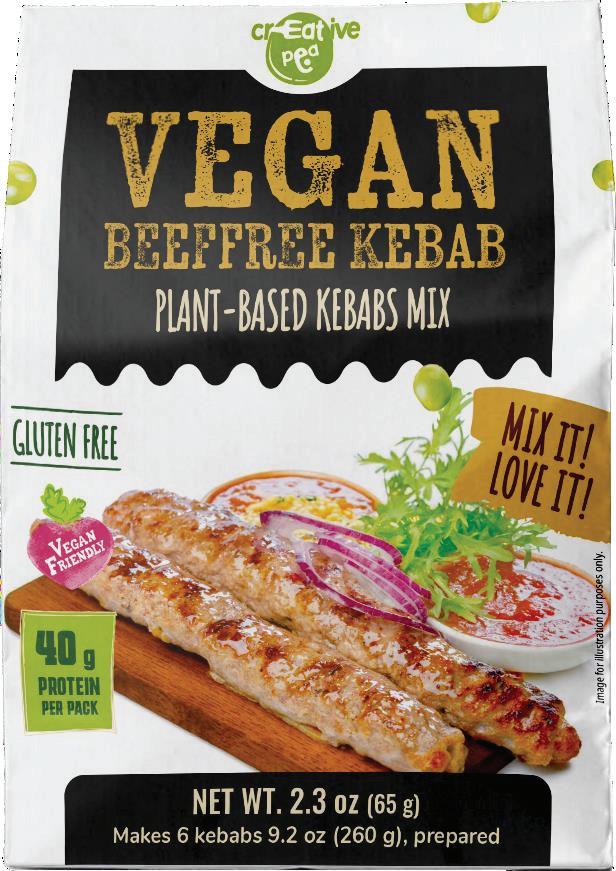
Vladimir Spivak, CEO of Creative Pea, stated that ANUGA was the ideal platform to showcase how Creative Pea has brought its innovation to the plant-based category. The show allowed visitors to experience how simple, tasty, and fun it can be to prepare plant-based meals. The brand presented its new 65g single-serve dry plant-based mixes
(Burger, Nuggets, Kebab, Fish Sticks).
These innovative, ready-to-mix solutions have been designed for busy consumers, families, students, athletes, and travellers. The products are also ideal for use in hospitals, restaurants, and hotels. They are shelf-stable for 18 months, clean-label, and rich in pea protein, meeting the global
demand for healthy, convenient, and sustainable foods.
“Our products fit naturally both in plantbased/vegan shelves and in convenience and dry goods aisles. We are expanding in the US, Europe, and Asia, with a strong focus on retail, foodservice, and e-commerce channels,” said Spivak.
“We use pea protein, a highly sustainable crop with low water and carbon footprint. Our dry-mix format reduces food waste and logistics costs (lightweight, no refrigeration needed). We also design innovative cardboard packaging with minimal plastic, in line with retailer and consumer demand for more sustainable solutions.”
Spivak added that the most significant opportunity for the category was in the mainstream adoption of plant-based foods beyond the vegan niche. At the same time, the challenges included price accessibility and differentiation.
Creative Pea is more than a product; it’s a movement for families, students, and communities to cook together, eat healthier, and enjoy plant-based meals without compromise. n



With its motto, “POP! BOBA MADNESS”, BOBA CHiC has positioned itself as the next-generation Asian beverage and cross-category RTD brand. Its products can naturally sit within RTD bubble tea drinks, sparkling drinks, Asian cuisine, or innovation-led beverage segments.
The brand showcased a portfolio of trenddriven innovations, including RTD pouch drinks with nata de coco, Sicilian Sparkling Coffee, a non-alcoholic popping boba cocktails kit, Black GABA Rice Matcha Amazake Latte, and Popping Boba Ramen. This year, the non-alcoholic MOCKTAIL KIT won the ANUGA INNOVATION TASTE award.
Each concept reflected key global trends: convenience, vegan, low-sugar, and crosscultural fusion. For example, its Sicilian Sparkling Coffee was made with only cold brew coffee and fresh lemon juice, a cleanlabel, refreshing beverage that directly addresses European consumers’ demand for natural, low-sugar drinks.
Meanwhile, its award-winning Black GABA Rice Matcha Amazake Latte has combined superfoods with traditional Taiwanese and Japanese wellness practices, offering both cultural storytelling and functional nutrition.
Mindy Jen, CMO of Empire Eagle Food Co., Ltd., said the most significant opportunity for the brand was in the globalisation of Asian beverage culture, particularly bubble tea, making Anuga the ideal platform to demonstrate not only product innovations but also how the brand has delivered differentiation and shelf excitement for retailers.
She said that consumers have moved beyond the classic milk tea format and have been exploring extensions such as RTD formats, sparkling beverages, mocktails, and even food hybrids.
At the same time, she mentioned that the biggest challenge will be balancing market education and supply chain efficiency, while ensuring authentic quality and exciting flavours meet regulatory compliance, logistics costs, and competitive pricing across different markets.
BOBA CHiC is the first bubble tea factory in Taiwan certified with the UK AA1000 Sustainability Standard, ensuring credible practices in energy management and responsible operations.
The brand is focused on expanding across Europe, the U.S., and the Asia-Pacific region, as Jen added that these regions have actively sought products that combine health, authenticity, and youth appeal. n





Bubble tea products, especially convenient formats like ready-to-drink, have rapidly gained popularity in the mainstream.
Leamaxx International has observed substantial growth potential across global supermarkets and retail chains, with a particular focus on North America, Europe, and the Middle East, where demand for innovative drinks has continued to rise.
Doris Lee, Marketing Manager at Leamaxx International, stated that the most significant opportunity lies in introducing bubble tea to mainstream retail and daily consumption, making it as healthy and accessible as coffee or other soft drinks, while the challenge will be balancing rapid innovation with scalability, ensuring consistent quality across diverse markets while adapting to evolving consumer preferences.
At ANUGA 2025, Leamaxx International showcased three products that were designed to meet consumer demand for fun, healthier, and “Instagrammable” drinks, the perfect crossover between functional refreshment and lifestyle enjoyment.

The Energy Bursting Boba – Volt Amber has fused the fun of popping boba with the bold zest of energy drinks, while the Sour Bursting Boba Collection has tapped into the Gen Z-driven trend for tangy, refreshing flavours.
Making its European debut, the Mini Bursting Boba Sparkling Drink readyto-drink innovation, has combined crisp sparkling soda with tiny, playful popping boba for a healthier, on-the-go beverage.
“We wanted visitors to experience Leamaxx not just as a one-stop bubble-tea partner, but as a versatile F&B solutions provider, offering popping boba, syrups, powders, teas, and OEM/ODM services,” said Lee.
“Our goal was for visitors to recognise us not only as innovators, but also as a reliable long-term partner.”
Bubble tea has evolved beyond a niche trend into a global lifestyle category. At Leamaxx, the team has committed to driving this movement forward with creativity, consistent quality, and a global supply network that supports its partners’ growth. n

Better-for-you Boba
OMG Bubble Tea presented a functional, reduced-sugar variation of bubble tea at Anuga 2025.
Ieva Jurevičienė, co-founder and COO, recognised that today’s consumers have been seeking beverages that are not only enjoyable but also healthier and aligned with wellness trends.
She said it was a real challenge to reduce sugar while retaining the texture, flavour, and indulgent experience consumers love.
“We are proud to say we’ve succeeded in creating a product that is both healthier and functional, with a source of fibre and without compromising on taste,” said Jurevičienė.
“Anuga is the largest food expo in Europe, making it the ideal stage to introduce our innovations to a broad audience. We believe visibility at such a prestigious event is key to building success.”
OMG Bubble Tea was created to bring bubble tea from speciality cafés to supermarket shelves in a convenient, highquality format. In just three years, the brand has expanded into 40 countries across three
continents, proving its global potential.
With rapid growth in Europe, Africa, and Asia, it's clear that OMG Bubble Tea is not just a drink; it’s an experience, a modern, better-for-you choice that blends fun, functionality, and flavour.
Sustainability is a core priority for OMG Bubble Tea as it has gradually moved to mono-material PP packaging for better recyclability and has already introduced paper straws to reduce plastic use.
All the electricity in its production facility comes from solar energy, helping minimise its carbon footprint.
“Buyers are seeking practical, transparent solutions, and we are committed to meeting these expectations while ensuring our products remain both convenient and enjoyable.”
As a pioneer in ready-to-drink bubble tea, the brand’s most significant opportunity has been to shape the category and surprise consumers with continuous innovation.
“To succeed, we must consistently deliver exciting, high-quality products that keep bubble tea lovers coming back for more.” n
ANUGA is the world’s largest trade fair connecting retail leaders, distributors, and food innovators.
For family business Panfruit Ukraine, it was the perfect place to show that Ukraine is not only a source of raw materials but also a country of value-added, design-driven, and tech-forward food products.
Panfruit is a brand that has blended flavour, aesthetics, and innovation; a brand that respects nature and creates snacks of the future.
Serhii Stetsenko, who co-founded Panfruit Ukraine with his wife Nina, said that despite the war, Ukrainian producers have not only been surviving but also setting trends.
He was deeply grateful to international partners for their support, as well as to ANUGA 2025, where the company presented its most innovative product, FrozenCloud freeze-dried ice cream.
The crunchy, creamy snack made with real ice cream and berries, shelf-stable and freezer-free, was a response to several trends, including healthy snacking, clean ingredients, novel textures, and guilt-free indulgence.
In addition, the company showcased a
bold new direction, freeze-dried savoury snacks, particularly green olives. This is a brand-new concept of a natural, crispy alternative to chips and nuts with full flavour and clean-label appeal.
“We are certified by Organic Standard and follow our '30-minute rule': berries are frozen within 30 minutes after harvest. This is not only about taste but also about reducing energy waste and preserving nutrients,” said Stetsenko.
“We are transitioning to mono-material packaging to ensure recyclability, and reducing transport volumes thanks to compact formats”
Panfruit Ukraine has already been working with EU countries and actively expanding into Scandinavia, Benelux, Japan, and the USA. Its product designs and packaging formats are adapted to local markets, for instance, a Nordic-inspired look for Sweden and matcha and yuzu flavours for Japan.
Looking ahead, the biggest opportunity for the brand will be in the shift from mass snacking to mindful snacking, where consumers seek function, story, and

Anuga 2023 was a landmark event for The Good Guys, as it was the brand’s first time exhibiting and where the team successfully found its first international distributors.
This year, Markus Klöf, Founder of The Good Guys, was proud to introduce two new product families. The first is a prebiotic, no-added-sugar, natural energy drink, and the second is a prebiotic soda enriched with Vitamin C and Zinc.
Both product lines aligned perfectly with several major consumer trends, including the rising interest in gut health, the demand for reduced sugar consumption, and the overall growth of the market for healthy, non-alcoholic beverages.
The Good Guys products are well-suited for global supermarket shelves, as they cater to the universal demand for healthier, functional drink options. The brand's
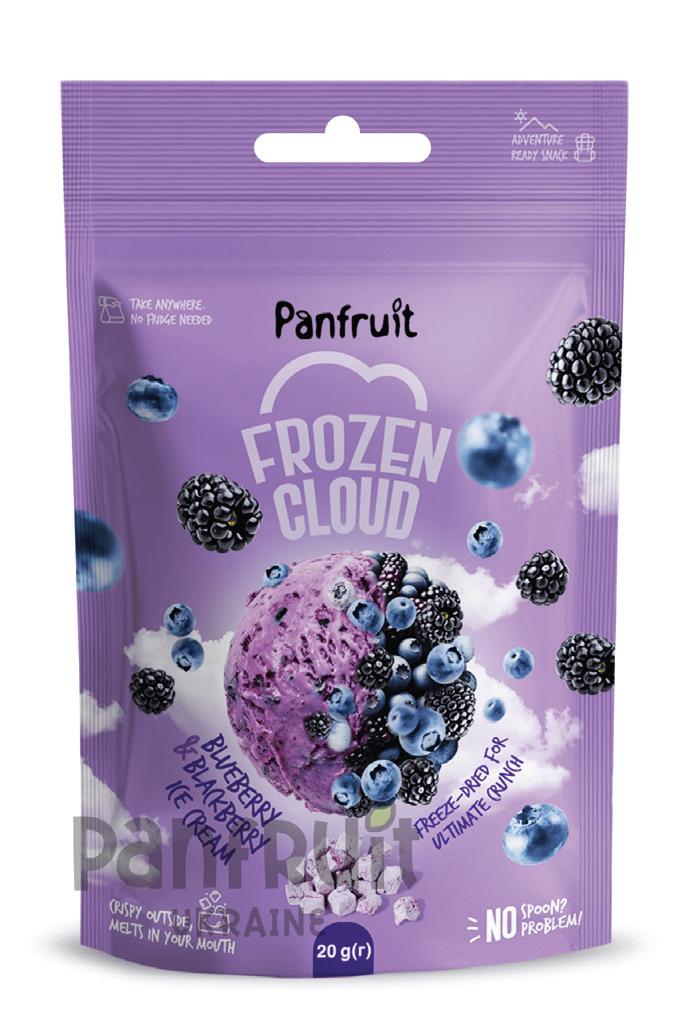
emotion, not just calories.
“Freeze-drying offers ideal answers to these expectations, but still requires education at the consumer level. The challenge is competition from large players who quickly replicate innovations. That’s why we focus on speed, authenticity, and staying ahead through design and experimentation.” n
primary focus for expansion has been the European market, given the strong existing interest they’ve already observed there.
“We are already known for our highquality organic kombucha, which is currently top-selling in Finland, which has been one of the leading kombucha growth markets 2018-2022,” said Klöf.
At the same time, Klöf added that the biggest challenge was the current instability in Europe and the lack of a unified set of standards across the continent, which hindered the creation of a single, large market.
However, the most significant opportunity was in the continued momentum of the gut health trend and the growing consumer demand for beverages with no added sugar.
Sustainability is another core value for the brand as it has successfully transitioned to fully BPA-free cans for all products.
Furthermore, the new production facility is certified under the FSSC 22000 standard, where it has focused on reducing waste and has successfully sourced responsible suppliers for its raw materials. n




Ustukiu presented several new products at Anuga that reflected both innovation and the brand’s commitment to meeting today’s consumer trends.
One of its highlights was the Summer Edition potato chips in three bold flavours - Pink Gin, Ketchup & Black Pepper, and Passion Fruit with Hot Spices.
These are not just traditional chips; they are thinner, lighter, and made using the latest technology that allows production without frying in oil. This significantly reduces fat content, making them a better choice for consumers who want to enjoy the fun of snacking while also being mindful of their health.
The striking packaging and adventurous flavours reflect a growing trend towards more playful, premium, and “unexpected” snacks.
In addition, Ustukiu introduced a new flavour in its sweet standard cakes lineRice Cakes with Milk Chocolate Flavour Coating. While chocolate might seem like a classic choice, the brand worked to make this product stand out with a modern, eyecatching blue package and a perfect balance of sweetness.
“This product is our way of bringing comfort and indulgence into a healthier format that consumers already love,” said
Rugile Uzdavinyte, Ustukiu Marketing Manager.
Ustukiu also showcased its new Mini Rice Crisps with Apple Juice. Uzdavinyte said that this product was especially close to the heart because it’s fun, natural, and ideally suited for children and families. It contains no added sugar; all the sweetness comes directly from the apples, aligning with the growing demand for clean-label, better-foryou snacks that don’t compromise on taste.
“Our innovations reflect three big consumer trends: healthier snacking, bold and exciting flavours, and fun formats for all ages. We aim to demonstrate that snacks can be both responsible and exciting, a treat that fits seamlessly into modern lifestyles without guilt.”
According to Uzdavinyte, the most significant opportunity was in the growing global demand for healthier snacks that don’t compromise on taste or enjoyment. Consumers have moved away from traditional fried or overly processed options and have instead been looking for products that combine healthy ingredients, honest labelling, and unique flavours.
At the same time, a primary challenge was that the snacking category is highly dynamic and competitive. Consumer preferences change quickly, and brands must be ready to adapt. This meant continuing to invest in innovation and technology while also staying closely aligned with our customers’ needs.
These products have a natural fit on supermarket shelves globally because they are made from simple, universal ingredients, combined with flavours that can be easily adapted to different consumer preferences.
“Snacking is a category that transcends borders, and we have the flexibility to adjust to suit local tastes.”
For a company like Ustukiu, with over 30 years of experience, Anuga has provided both visibility and credibility - it is where meaningful conversations take place and new trends are born.
Currently, Ustukiu has already been exporting to Belgium, the Czech Republic, Latvia, Spain, the United Kingdom, the United Arab Emirates, Denmark, the Netherlands, Turkey, Poland, Ukraine, Georgia, Romania, Bulgaria, Finland, and Bosnia and Herzegovina. n


A Pod For Every Mood. Colours spark emotions, and air up’s Liquid Rainbow flavour pack has a colour for every feeling. Enjoy the new way of drinking pure while experiencing flavour through scent. Zero sugar, zero calories, only natural aroma.
The scent of the pods is derived from only natural ingredients, such as fruits, spices, and herbs, which are applied to a food-safe carrier material.
The Liquid Rainbow flavour packs come

with five pods, bringing Scentaste to over 25 litres of water. This pack includes: Guava Crush - Pink: Soft glam, pop star chaos; Apricot Glow - Yellow: Optimistic, serotonin-core; Kiwi Chill - Green: Grounded, comforting; Berry Bold - Red: Loud, unapologetic; and Energy RushBlue: Awake, energetic.
A single pod flavours around five litres of water. Assuming consumption of 1.5 L per day, this 5-pod pouch will last consumers at least 17 days.






Ball Corporation is a nearly USD 12 billion company with more than 145 years of experience in packaging.
Today, the company offers the broadest portfolio of aluminium beverage, personal care, and home care products in the industry, helping customers meet their goals, from growing market share to reducing environmental footprints or engaging consumers in new ways.
With 16,000 colleagues worldwide, over 65 manufacturing plants, and more than 108 billion units shipped annually, its scale has enabled it to achieve this with both reach and resilience.
“What sets us apart is that we’ve
committed fully to aluminium because we believe in its sustainability attributes,” said Tomisin Fayemi.
“Unlike other packaging materials, aluminium is an example of a truly circular material, as it can be recycled again and again into the same type of product, while minimising waste, maintaining its value and its inherent quality.”
This year marked the 90th anniversary of the Ball Corporation’s can history. The technology has evolved exponentially and has already achieved some of the highest recycling rates of any format. Every can put

on the market is not only a container but also a resource, ready to be collected, melted and remade into new cans.
In the United States, an aluminium can has the potential to be recycled back into another can in as little as 60 days. It’s a proper closed-loop system, and scaling this system is central to how the company has created value for its customers.
“Our determination to create a world free from waste underpins everything we do, from how we operate to how we innovate new packaging formats.”
Recently, the company was recognised for its Dynamark Advanced Pro at September’s World Beverage Innovation Awards 2025 in the Best Packaging/Labelling Innovation category at Drinktec in Munich, Germany.
“We’re thrilled with the recognition because it reinforces our belief that we’re heading in the right direction: helping
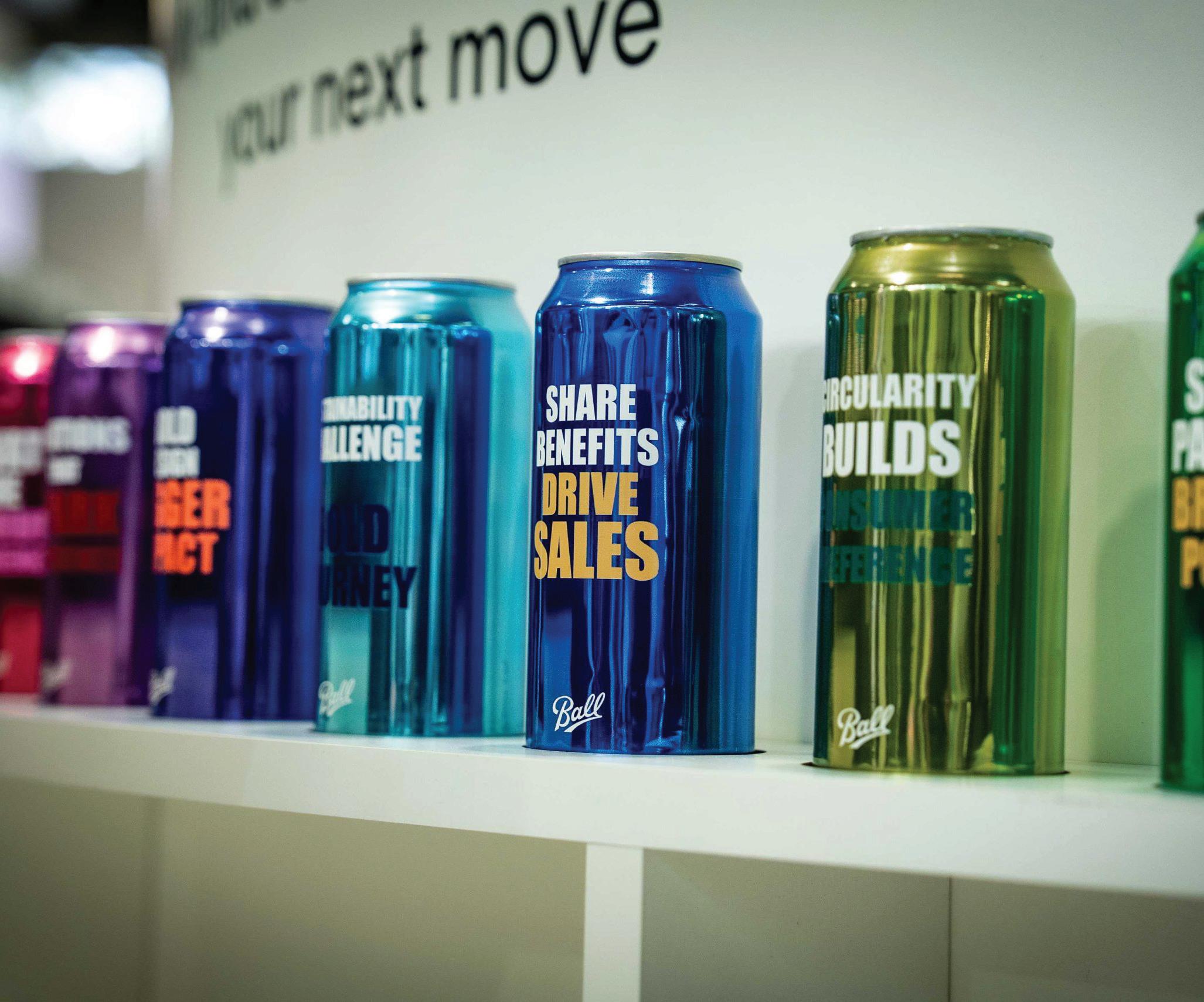
brands forge stronger connections with consumers and create packaging that’s both eye-catching and meaningful.”
Over ten years ago, Dynamark Starter changed the game with campaigns like Share a Coke. Then, Dynamark Pro introduced high-definition imagery to cans, enabling global campaigns to connect with millions of fans.
Dynamark Advanced Pro is the next evolution, allowing brands to print up to 12 unique designs within a single production run, enabling limited editions, seasonal packaging, personalised campaigns, and collectable sets, all within standard manufacturing formats.
This flexibility has opened the door to richer visual storytelling with expanded design possibilities, enhanced colour depth, and intricate halftone details that help brands differentiate themselves while meeting the rising demand for customisation and collectability.
Another important priority for the company has been delivering on its Climate Transition Plan, which outlined how it will reduce absolute greenhouse gas emissions by 55 percent across its value chain by 2030, on the path to net zero between 2040 and 2050.
“It’s not just a set of long-term ambitions. It’s built on clear milestones and transparent reporting so that customers, policymakers and consumers can see real progress year by year,” added Fayemi.
“That level of proof is becoming nonnegotiable in today’s packaging landscape,
and we’re committed to leading from the front as we design and produce fully circular aluminium packaging products.”
The Climate Transition Plan was also commended at the World Beverage Innovation Awards and shortlisted for the Sustainability Initiative category, highlighting the importance of pairing bold ambition with transparency and accountability.
Looking ahead, Fayemi said that regulation will hard-wire circularity into the packaging space. In Europe, the EU’s Packaging and Packaging Waste Regulation sets a target of 90 percent separate collection by 2029, including metal cans.
In the UK, the Deposit Return Scheme is scheduled to go live in October 2027, which will clearly favour formats that are highly recoverable and easy to sort. This will present a real opportunity for Ball Corporation to optimise can specifications and graphics for deposit systems, supporting accurate closed-loop recycling.
As analysts expect demand for cans to continue growing, Ball’s portfolio has positioned it well to help brands meet that demand while also delivering better realworld recycling outcomes.
“Sustainability is top of mind. Aluminium can give consumers confidence that their choices matter, while helping brands and retailers deliver on sustainability commitments in a way that is proven, scalable and future-ready, as it is the most recycled beverage container globally.” n





drinktec has reaffirmed its position as the world’s leading trade fair for the beverage and liquid food industry.
Over 58,200 visitors from 164 countries gathered inspiration for future product concepts, business strategies, and technical solutions. With 70 percent of attendees coming from international markets, drinktec 2025 once again lived up to its reputation as the industry’s premier global platform. Approximately 30 percent of visitors came from Germany, around 40 percent from the rest of Europe, and the remaining 30 percent from other regions worldwide.
Decision-makers from the world’s top 20 beverage corporations were once again in
attendance, bringing large delegations to explore the future of beverage and liquid food production.
At the same time, countless small and medium-sized enterprises from around the globe also used drinktec as a key platform for investment decisions. The event thus represents the full spectrum of industry players.
A total of 1,117 exhibitors from 68 countries showcased solutions covering the entire value chain of beverage and liquid food production across a net exhibition area of 74,000 m². This year, particular focus was



placed on modernisation projects, process optimisation, digitalisation, and strategies for developing new beverage concepts based on novel ingredients, formulations, and production methods.
For many exhibitors, drinktec once again provided the stage to present their latest product innovations. Visitors could use the Innovation Guide to locate innovation hotspots within the exhibition halls.
New to the portfolio was the Liquidrome, an interactive networking and discussion area. Through its diverse offerings, drinktec introduced a new dialogue format featuring expert presentations, panel discussions, and keynote speeches on the industry’s future
topics, offering visitors fresh inspiration.
“The level of interest in the industry’s future topics has never been higher.
The Liquidrome, with its programme of presentations and panel discussions, proved to be the perfect platform for expert exchange. It was extremely well attended and undoubtedly a highlight of this year’s event,” said Richard Clemens, Managing Director of the VDMA Food Processing and Packaging Machinery Association, the event’s conceptual partner.
The Liquidrome area was complemented by a Health Bar, offering tastings of health-focused product innovations, which attracted great interest among visitors. The expanded Startup Area with 20 national
and international startups once again highlighted drinktec as a fertile ground for innovative product and solution approaches.
“This year’s drinktec has once again impressively demonstrated that Munich provides the perfect platform for the global beverage and liquid food industry,” said Markus Kosak, Executive Director of drinktec.
“The exhibitor and visitor numbers underscore the importance of high-level exchanges and deep insights into technology and innovation. With its innovations and live demonstrations, drinktec has as always won over a great many visitors. We look forward to the next drinktec from 11 to 15 September 2028.” n























The cost of living still soaring, many consumers are looking for ways to save money at the supermarket.

Unilever has agreed to sell prestige skincare label Kate Somerville to Rare Beauty Brands.
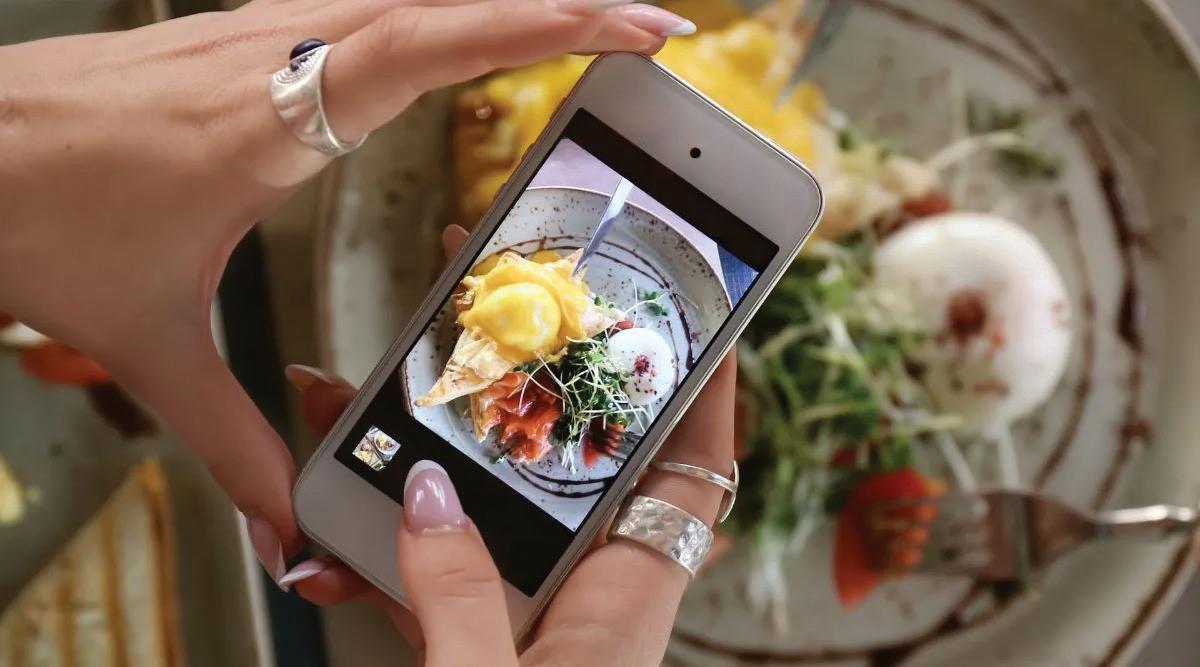
‘Trend Loyalty’, an emotionally charged, fastmoving allegiance driven by viral moments rather than long-term trust.

PepsiCo, Inc. has named Steve Schmitt Executive Vice President and Chief Financial Officer.

Coles has brought a brand-new shopping experience to South Australia, with the opening of its first Coles Local store in Adelaide.

The Children's Food Campaign has been campaigning on junk food promotions and marketing for over 20 years.

Brickley has been instrumental in shaping CCEP’s digital transformation journey, strengthening IT capabilities, and driving innovation across the business.

NielsenIQ, in collaboration with the World Data Lab (WDL), has revealed that Generation X has emerged as a trillion-dollar consumer powerhouse in the Asia Pacific






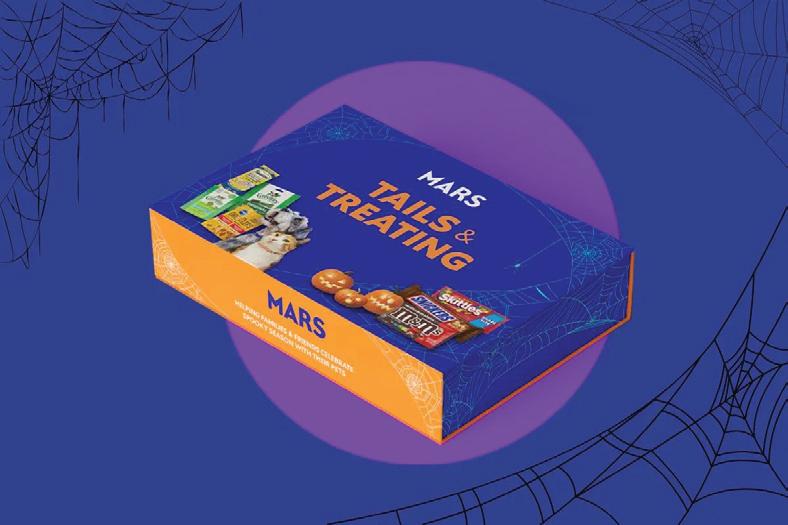
Mars
As one of the world’s largest food and pet companies and the authority on Halloween in the United States, Mars, Incorporated has ensured both people and their pets can celebrate the season together.
Approximately 43 percent of U.S. pet owners plan to include their pets in Halloween festivities this year, according to a recent Ipsos and Mars survey.

Coca-Cola
Diet Coke has announced the comeback of its iconic Diet Cherry Coke.
First launched in the 80s, the fanfavourite flavour will return to shelves in Great Britain, in packaging inspired by its original retro look.
With cherry reported as the flavour of the year, Diet Cherry Coke offers the same crisp taste of Diet Coke, now with a deliciously bold twist, just as the cosy season approaches.
Quality Street
Quality Street has added a twist to Christmas this year with a brand-new limited edition sweet, but in a festive first, its flavour will remain a mystery until December. Joining last year’s popular Coffee Creme, the new sweet will be available exclusively at John Lewis and Waitrose stores nationwide. It will feature in the muchloved pick and mix stations, which are returning for the festive season

Nescafé
Nescafé Dolce Gusto has brought NEO, its nextgeneration coffee system, to Asia for the first time. Japan and Korea will be the first markets in the region to roll out this innovative coffee system, which combined cutting-edge technology with a new range of home-compostable, paper-based pods, ensuring no compromise on taste and quality.

Eggo
Eggo has brought breakfast to another dimension with a brand-new waffle inspired by Netflix's Stranger Things.
Just in time for the fifth and final season, the brand has launched Eggo Stranger Things Strawberry Waffles, its first-ever strawberry red waffle with colours from natural sources.
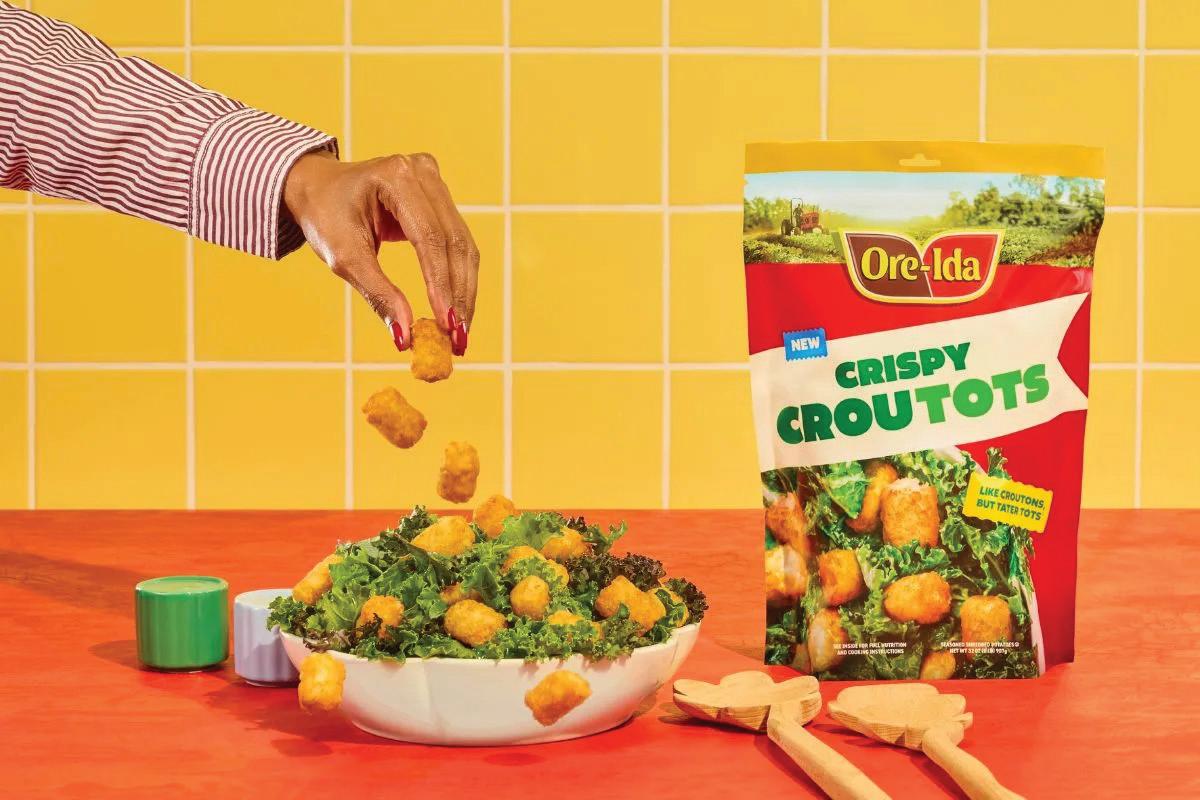
Ore-Ida
Ore-Ida, the inventor of Tater Tots and a brand that has been serving up golden, delicious potatoes to American households for more than 70 years, has shaken up salad bowls everywhere with its latest launch.
CrouTots, inspired by #SaladTok and the cultural obsession with adding a side of fries to any salad order, bring crunchy potato goodness to salads, reinforcing that leafy greens don’t have to be boring and making it easier than ever to turn everyday salads into irresistible, flavourful meals.
With a satisfying crunch and savoury flavour, CrouTots transform any bowl of greens into something worth eating. With 77 percent of Americans making mealtime decisions based on trending online content, Ore-Ida is bringing one of social media’s most unexpected salad hacks straight to the table for a limited time.

KitKat
The all-new KitKat Minis range is set to delight consumers, offering the iconic crispy cocoa wafer in an exciting, shareable mini format.
The KitKat Chunky Minis will be delivering the same chunky taste you love, but in a smaller size.
For those who crave variety, the KitKat Two Finger Mini Mix has a delightful assortment of flavours in one convenient bag, including milk chocolate, white, hazelnut, salted caramel and peanut butter.
The KitKat Chunky Minis hit shelves in August and will be followed by the launch of the KitKat Mini Mix in September.

Cheez-It
Cheez-It has unleashed its biggest innovation in three years, something unlike anything fans have ever crunched before.
Enter Cheez-It Crunch, a bold new snack lineup that combines 100 percent real cheese with a more satisfying crunch and a 3D shape designed to deliver edge-to-edge bold flavour in every bite.





FairPrice Group (FPG) is Singapore’s largest retailer, with over 570 touchpoints, more than one million customer interactions daily, and 1.7 million digitally connected customers using the FPG app.
Technology has been a key enabler of its growth in recent years, but if there’s anything that the last few years of global disruption have shown, it’s that the only certainty in retail is how quickly consumer needs and preferences evolve.
FPG’s ambition is to become Asia’s most admired retailer, and its Store of Tomorrow (SOT) programme has been a key pillar of achieving this ambition.
The SOT programme is a commitment to pilot more than 20 new digital initiatives a year over the next three years, to meet consumer demand for seamless, hyperpersonalised, omnichannel retail experiences.
Vipul Chawla, Group CEO, FairPrice Group, said that the physical Store of Tomorrow launch in Punggol Digital District, Singapore’s ‘Silicon Valley’, was
the first significant milestone on the SOT programme.
The store currently features gen-AIenabled consumer technology such as Smart Carts, virtual shopping assistants, and digital price cards. It will serve as a testbed for retail technology pilots that could be implemented across the network.
Smart Carts have built-in displays that can support customers with in-store navigation, highlight promotions for nearby products, provide product recommendations based on shopper purchase history, and scan-and-go functionality.
Digital Price Cards, electronic shelf labels, and promotion cards that can be remotely updated with different product and price listings, significantly reducing staff time spent on printing and replacing physical cards and reducing our paper usage once fully rolled out across over 160 supermarket outlets.
The Unity Recommender gen-AI shopping assistant provides customers with tailored recommendations for health supplements that can help them achieve their health goals, based on a short in-store body composition analysis.
At the same time, the Digital Wine Sommelier can provide shoppers with personalised wine recommendations based on their preferences and shopping history.
Additionally, the Omnistore concept was built on increasingly hybrid online/brickand-mortar consumer shopping behaviour to more seamlessly connect physical and digital shopping experiences for customers, removing physical store limitations and providing greater product selection.
FPG has also been working to integrate digital solutions to provide customers with even more streamlined, seamless checkout options in stores.
By having customers verify their FPG App data through the Singapore government’s digital personal data vault MyInfo, its discount schemes for vulnerable customers that typically would require them to show physical verification cards (Pioneer and Merdeka generation, CHAS Blue and Orange) will be automatically applied at self-checkout, as long as customers use their FPG App for payment.
Vision AI is another solution that has leveraged existing in-store CCTV infrastructure and advanced video analytics to provide real-time updates to staff on where support or intervention is required

throughout the store.
Chawla added that a growth mindset drove FPG teams, who are bold, open to new ideas, embrace challenges, and continuously learn.
“With the Store of Tomorrow, we fully expect that not all of the technology pilots we intend to roll out over the next few years will succeed. Our philosophy is to fail fast so we can learn fast and implement solutions that actually make our stakeholders’ lives better, from our customers to our frontline workers in the store,” said Chawla.
“At the end of the day, FairPrice Group’s purpose is to make every day a little better for those we serve, and our daily commitment to this purpose is what sets us apart.”
The FairPrice City Square Mall outlet also reflects the company’s sustainability commitment, serving as a benchmark for how it can incorporate environmental care across its retail operations in the years to come.
The outlet features more than 400 sustainable products, including responsibly made household staples like dishwashing liquid and paper products, items with reduced packaging, locally farmed fresh produce, and more.
“We are deeply committed to supporting the growth of Singapore’s local produce scene, and we do our best to provide local farmers and producers with a platform to showcase their products to a larger audience through initiatives such as our SG Farmers Market and Made in Singapore Fair.”
The store is also a zero-food waste store,

where any potential food waste is treated by the mall’s food digester, and blemished fresh produce is sold at discounted prices through the IMPerfect Fellas programme or donated to communities in need through the Neighbourhood Food Share initiative.
“Our customers are increasingly conscious of the importance of sustainable food sources and supporting our local producers. We are working hard to reflect this growing demand in our retail offerings.”
The FairPrice Store of Tomorrow is located in Punggol Digital District, a business, commercial, and residential hub for emerging technologies, reflecting the company’s commitment to digital integration, innovation, and redefining retail experiences through the store. n





